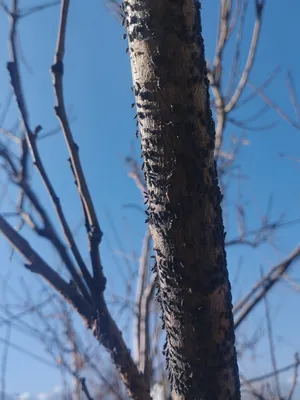A Complete Guide to Planting, Pruning and Caring for a Peach Tree in the UK
A Complete Guide to Planting, Pruning and Caring for a Peach Tree in the UK
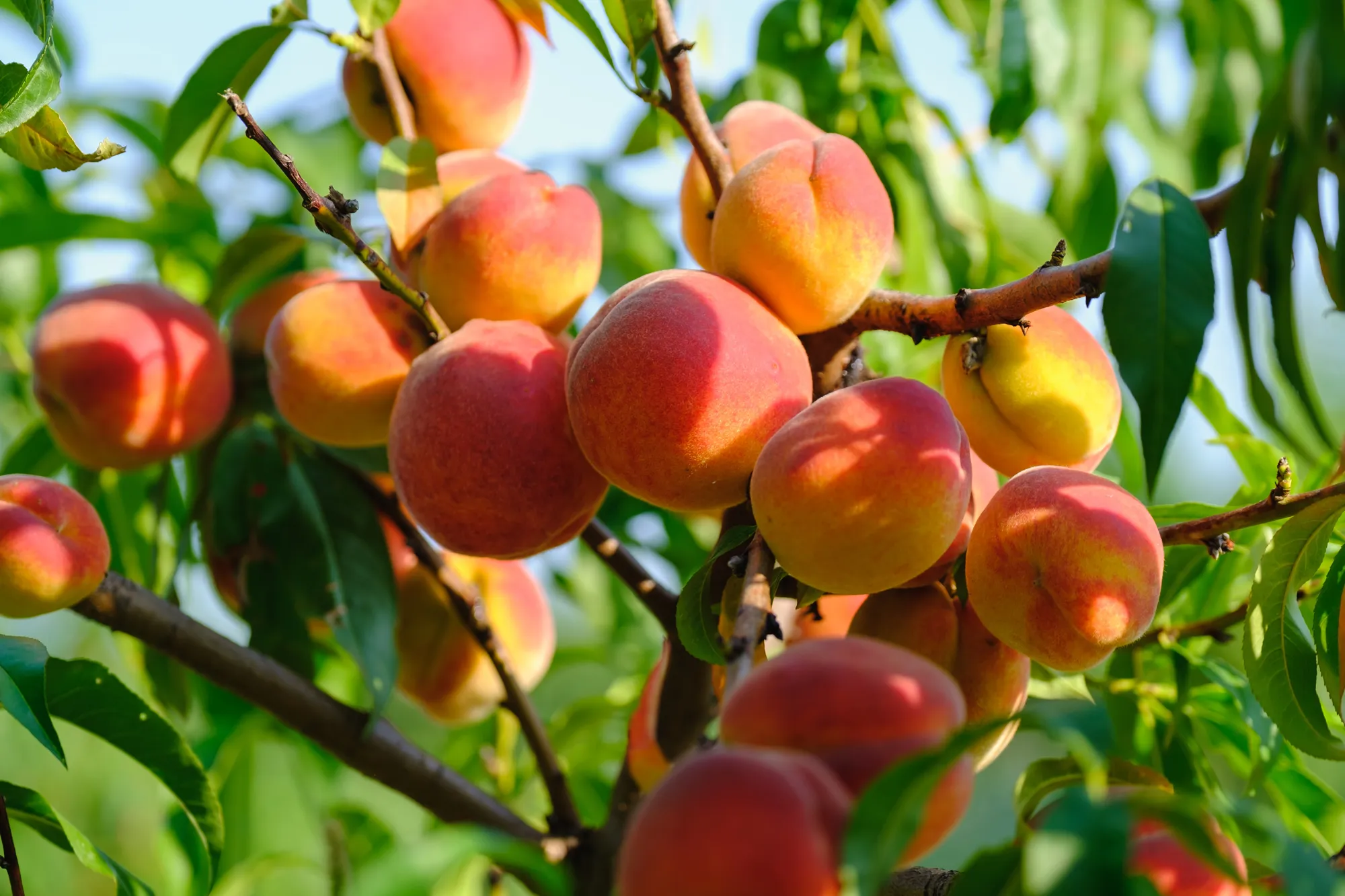 Ripe peach close-up with peach orchard
Ripe peach close-up with peach orchard
Are you longing for delicious and juicy peaches right from your outdoor garden in the UK? If so, look no further than planting a peach tree! As summer approaches it can be tempting to buy pre-harvested fruits and vegetables for convenience – but growing your own tasty produce like a peach tree is worthwhile. Not only will you get a reliable source of fresh fruit every year with minimal effort, but tending to plants is always an enjoyable activity! In this guide we'll cover all aspects of successful peach tree growth and maintenance in the UK, giving you everything you need know about planting, caring for and harvesting peaches from your home. So if ready to give it a go - let’s get started!
Pruning peach trees involves a lot of learning, but it is a fulfilling activity and one that will benefit your tree in the long run. When it comes to pruning, there is no one-size-fits-all approach; instead, you must assess each situation individually and tailor the pruning style to what works best for the peach tree. With practice and patience, you can keep your peach tree healthy and productive for years to come. What’s more, with careful pruning, you should be able to enjoy a generous bounty of juicy peaches each season! So don't be afraid to don your gardening gloves and start pruning your peach tree today—you won't regret it!
In conclusion, growing a peach tree in the UK is an achievable goal. But successful growth depends on a few key factors: proper soil preparation and planting depth, adequate watering schedule, well-draining soil, and how to care for young trees during the first year. Weather conditions such as temperatures, humidity and moisture are also important considerations. It is also important to be aware of common pests and diseases which can affect your Peach Tree. Overall, if you follow these tips carefully you can successfully grow not just one but multiple peach trees in the UK with mouthwatering rewards at the end of every season. So get out those garden gloves, grab some gardening tools and start planting your own Peach Tree today!
An Overview of a Peach Tree
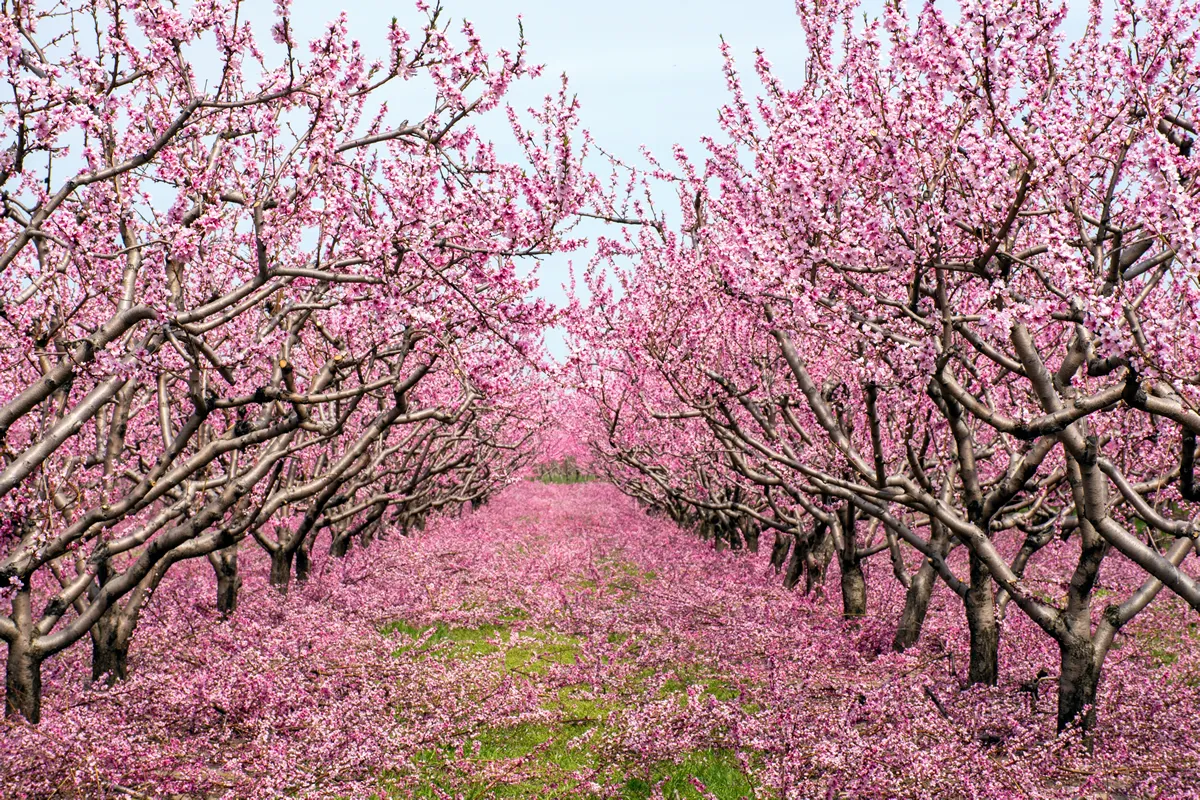 Peach and cherry trees bloom in Niagara on the Lake, Ontario, Canada.
Peach and cherry trees bloom in Niagara on the Lake, Ontario, Canada.
If you're a gardening enthusiast, then having a peach tree in your backyard could be a great addition to your collection. These trees not only look beautiful when they bloom, but they also bear some delicious fruit. Peach trees require adequate sunlight, well-drained soil, and proper watering for healthy growth. Proper pruning of the branches is also necessary as it helps in the overall health of the tree. Whether you're interested in growing your own fruit or just want to add some greenery to your garden, a peach tree is definitely worth considering. With a little effort and care, you'll be able to enjoy a bountiful harvest of juicy peaches right from your own backyard.
The Peach Tree, scientifically known as Prunus persica, is a fascinating specimen in the world of botany. Physically, the peach tree is typically small to medium in size, ranging from 10 to 30 feet tall. It features a relatively broad crown with branches that ascend and spread, forming a rounded shape. The trunk of the tree can reach up to half a foot in diameter. The leaves of the peach tree are lanceolate, characterized by a simple ovular shape with pointed tips. They are a vibrant, glossy green colour, often with glands at their bases that secrete a fluid known to attract ants. The peach tree's leaves are arranged alternately and are both slender and pointed.
In early spring, the tree bursts into bloom with delicate pink flowers appearing on its bare branches. These blossoms will eventually give way to the tree's renowned fruit. The peaches themselves are juicy and fleshy, typically yellow to orange in colour, often tinged with red. They have a rough pit or stone at their center and are covered in a distinctive fuzzy skin. Some varieties of the peach tree produce nectarines, which are similar to peaches but have a glossy, non-fuzzy skin.
The lifecycle of the peach tree begins with seed germination. After the peach pit has been planted and watered, it takes several weeks for a new tree to sprout. This vegetative period is crucial for the tree's growth and development. Once matured, the tree enters the flowering phase, producing pink blossoms that will eventually become fruit.
Ecologically, the peach tree plays a significant role in its ecosystem. Its blossoms attract a wide variety of pollinators, including bees and butterflies, which help to fertilize the flowers and ensure the production of fruit. The tree also provides habitat and food for various species of birds and mammals.
Actinomycetes, a type of bacteria found in soil, play an important role in the successful growth of the peach tree. They help to break down organic material in the soil, improving its quality and providing essential nutrients for the tree's growth. In terms of human consumption, peaches are a popular fruit worldwide. They are consumed fresh and are also used in a variety of dishes, from desserts to savory meals. Moreover, peaches are rich in vitamins and minerals, contributing to human health. In conclusion, the peach tree is not just a provider of delicious fruit, but also a key player in its ecosystem. Its physical characteristics, lifecycle, and ecological significance make it a truly remarkable species.
The History of a Peach Tree in the UK
 Peach tree with fruits growing in the garden
Peach tree with fruits growing in the garden
The history of a peach tree in the UK is a testament to the persistence and resourcefulness of farmers and gardeners alike. Despite the climate not being ideal for peach trees, growers have found ways to cultivate them and create a thriving industry. While originally brought to the UK by the Romans, the peach tree didn't take root until the 16th century when Henry VIII's gardener brought over a new variety. Today, the cultivation of peaches is a fine art, with numerous growers tending to the trees with great care and attention to detail. The history of the peach tree in the UK is a classic example of how human ingenuity can overcome even the greatest obstacles to create something truly remarkable.
The Tale of the Solitary Peach Tree: A British Legacy
Nestled in the verdant heart of Kent, where the rolling downs meet the sky, stands a singularly enchanting peach tree. Unlike its cousins native to China, this tree has a unique story, one that weaves together history, community, and the indomitable spirit of nature.
The peach tree, Prunus persica, is an alien in these climes; its roots trace back to Northwestern China, near the foot of the Tibetan mountains. Yet, our tree, known locally as the 'Kentish Peach', found its way to the UK shores in the 16th century, borne on the waves of trade and exploration.
The journey of the Kentish Peach began with a single pit, carried aboard a merchant ship by an adventurous botanist. On reaching England, this pit was planted in the fertile soil of Kent, forever changing the landscape. Over the years, the tree thrived in its adopted homeland, growing tall and strong, its branches heavy with luscious, sun-kissed fruit. The Kentish Peach quickly became a beloved part of the local community. Its pink blossoms heralded the arrival of spring, while its succulent fruits signified the height of summer. For generations, families have gathered under its boughs for picnics, children have played in its shade, and lovers have exchanged vows beneath its fragrant canopy.
More than just a tree, the Kentish Peach has become a symbol of endurance and adaptation. Its presence serves as a testament to the power of nature to overcome adversity and flourish in foreign soils. And in this, it holds a mirror to the diverse and resilient community it has come to represent.
The tree's surroundings are equally captivating. It grows on the edge of a meadow, bathed in sunlight, and serenaded by the gentle hum of bees and the occasional trill of a songbird. Around it, wildflowers bloom in a riot of colours, their sweet scent mingling with the heady aroma of ripe peaches.
Adding a touch of myth and magic to its tale, the Kentish Peach is often associated with the Greek myth of Hesperides. In this ancient tale, a sacred garden bearing golden apples (often thought to be peaches) was guarded by nymphs. The tree's golden fruit and its resilience echo this myth, adding a layer of mystery and intrigue. As an emblem of the community's history, the Kentish Peach continues to stand tall, its roots deep in the land it adopted centuries ago. It is a living testament to the enduring bond between humans and nature, a bond that transcends geographical boundaries and time. Its story, like its fruit, is a blend of sweetness and richness, a testament to the beauty of life's unexpected journeys.
The Different Varieties of a Peach Tree
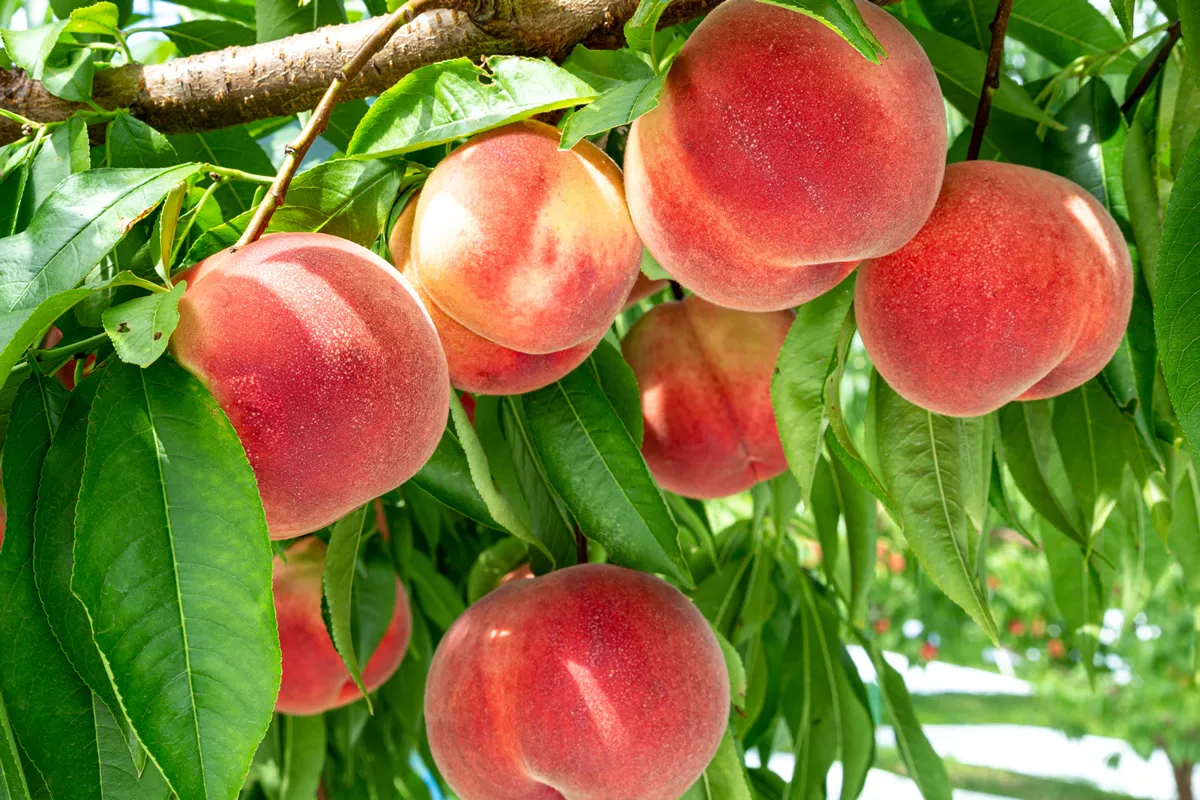 Fresh and delicious peaches in the orchard.
Fresh and delicious peaches in the orchard.
Gardening enthusiasts have long been fascinated by the many different varieties of peach trees. From the juicy and sweet Elberta to the blushing, crimson-red Indian Blood, each type of peach tree offers a unique set of characteristics and flavour profiles. Whether you prefer a softer, melt-in-your-mouth peach or a firmer, more tangy variety, there's something out there for every gardener to discover. With careful planning and proper care, you too can enjoy the sweet rewards of cultivating your very own peach tree!
Certainly, here are some peach tree varieties that are suitable for cultivation in the UK:
Sweet Elberta:
This is a classic peach variety known for its large, yellow fruit with a red blush. The Sweet Elberta offers a juicy, sweet taste and is excellent for fresh eating, canning, or baking. It's a self-fertile variety and requires full sun and well-drained soil. Regular pruning will help maintain its shape and promote better fruit production.
Crimson-Red Indian Blood:
An unusual yet captivating variety, the Indian Blood Peach produces distinctive deep red fruits with a rich, sweet, and slightly tart flavor. It's a vigorous grower and requires a sunny, sheltered spot with well-drained soil. It's also self-fertile and resistant to common peach diseases, making it a robust choice for UK gardens.
Avalon Pride:
Known for its resistance to Peach Leaf Curl, Avalon Pride is an early-bearing cultivar that yields fruit in early August. The tree thrives in full sun and well-drained soil, and it needs regular watering during dry periods. The fruit is large, with a beautiful blush over a yellow background, and offers a juicy, sweet flavor.
Peregrine:
Peregrine is renowned for its white-fleshed, super-sweet fruits. It prefers a sunny, sheltered spot and well-drained soil. It's self-fertile, so there's no need for another tree for pollination. The fruits are medium-sized with a velvety texture and a classic peach flavor.
Rochester:
This variety is known for its reliability and hardiness. Rochester bears yellow-fleshed fruits with a robust peach flavor that holds up well in cooking. It's a self-fertile variety that does well in full sun and well-drained soil. Regular pruning will keep the tree healthy and productive.
Amsden June:
A frost-resistant variety, Amsden June is suitable for cooler parts of the UK. It produces sweet and juicy white-fleshed fruits. It requires a sheltered spot in full sun and well-drained soil. Regular watering and feeding will ensure a good harvest.
Red Haven:
Ideal for small gardens, Red Haven on Montclare rootstock grows to a neat 3 x 3m size. It produces a good crop of medium to large, juicy peaches with excellent flavor. The tree does well in full sun and needs well-drained soil. It's also self-fertile, so no need for a second tree for pollination.Remember, while these peach tree varieties are typically hardy and suitable for the UK climate, local conditions can vary, and it's always a good idea to consult with a local nursery or extension service for specific advice about your area.
How to Propagate a Peach Tree in the UK
Peach trees are a beautiful and bountiful addition to any garden, and propagating them is easier than you may think. To get started, choose a healthy and mature peach tree that you wish to propagate from. Cut a stem that is around one-year-old, approximately 20cm long, and has no flowers or fruit growing on it. Remove all the leaves from the stem except for two or three at the top. Dip the cut end of the stem in rooting hormone powder, and place it into a pot filled with soil and perlite. Water the cutting and place a plastic bag over the top to create a greenhouse effect. After a few weeks, when the stem has taken root, remove the plastic bag and place the pot outside in a sunny location. Your new peach tree will start to grow and thrive, and in a few years, you'll be able to enjoy the fruit of your labour!
A Comprehensive Step-by-Step Guide to Propagate a Peach Tree using the Softwood Cutting Method
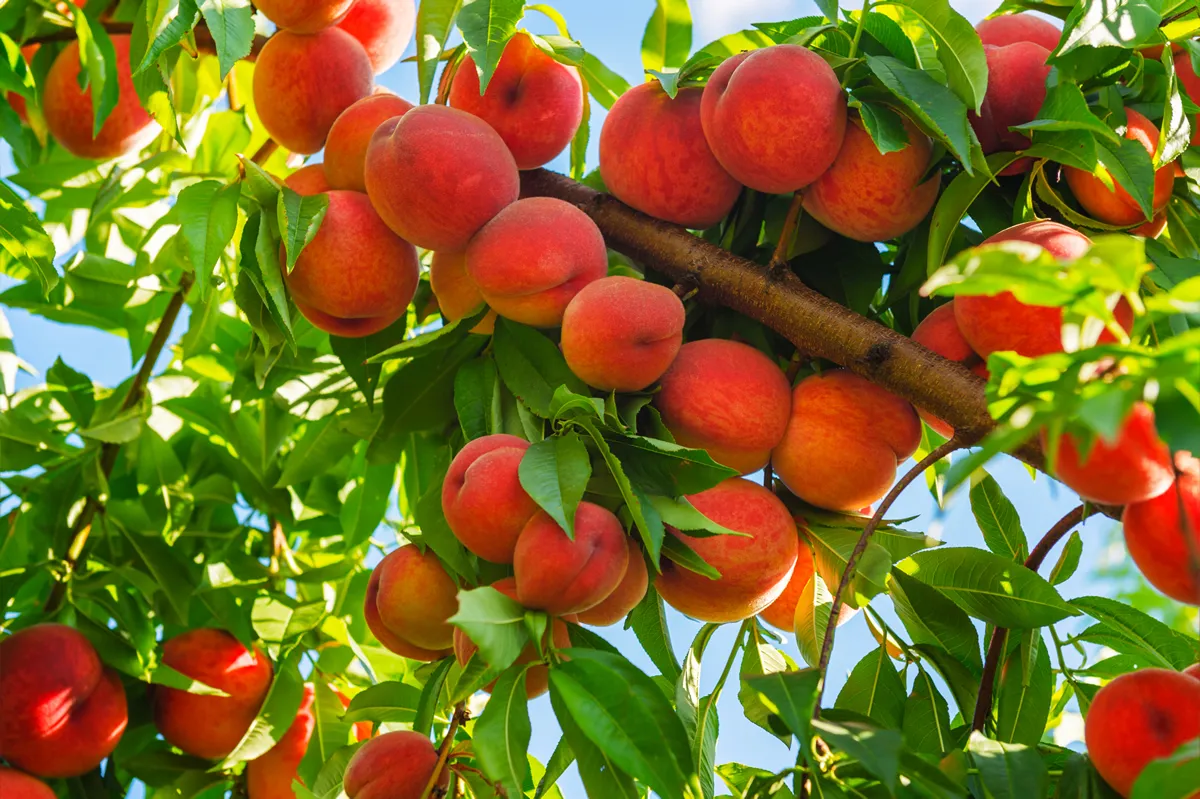 Peach tree with fruits growing in the garden
Peach tree with fruits growing in the garden
Softwood cuttings are taken from new growth, typically in the late spring or early summer when the peach tree is actively growing. Here's how to propagate a peach tree using this method:
Materials Needed:- Pruning shears or a sharp knife
- Rooting hormone
- Pot with drainage holes
- Peat-based potting mix or sand
- Clear plastic bag or a plastic bottle
- Twist ties or rubber bands
- Find the Right Stem: Identify a healthy branch on your peach tree that has new growth. The perfect cutting is about 6 inches long, has leaves at the top, and is relatively straight. The stem should snap easily when bent; this indicates it's still in the softwood stage.
- Prepare the Cutting: With a clean, sharp knife or pruning shears, cut just below a leaf node (where a leaf attaches to the stem). Remove the leaves from the lower half of the cutting, leaving a few at the top.
- Apply Rooting Hormone: Dip the cut end of the stem into rooting hormone. This will encourage root development and increase the chances of successful propagation.
- Plant the Cutting: Fill a pot with a peat-based potting mix or sand. Make a hole in the center of the potting mix with your finger or a pencil. Insert the cut end of the stem into the hole and firm the soil around it.
- Create a Mini Greenhouse: Cover the pot with a clear plastic bag or cut off the bottom of a plastic bottle and place it over the pot. Secure the bag or bottle with a twist tie or rubber band. This creates a humid environment that encourages root growth.
- Care for the Cutting: Place the pot in a location with bright, indirect light. Avoid direct sunlight, which can cause the cutting to dry out or overheat. Water the cutting regularly to keep the soil moist but not waterlogged.
- Wait for Root Development: After six weeks, gently tug on the cutting. If there's resistance, it means roots have developed. At this point, you can remove the plastic covering and begin to acclimate the new plant to its environment.
- Transplant the Cutting: Once the cutting has developed a strong root system, usually after several months, it can be transplanted into a larger pot or directly into the ground.
Remember, patience is key when propagating peach trees. Not every cutting will develop roots, so it's a good idea to take several cuttings to increase your chances of success. Good luck!
A Comprehensive Guide to Growing a Peach Tree from Seed
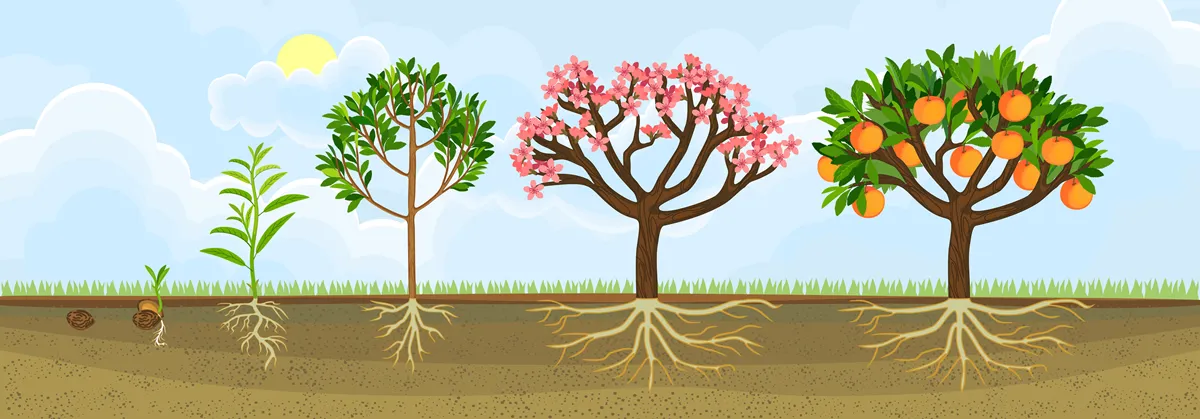 Life cycle of peach tree.
Life cycle of peach tree.
Growing a peach tree from seed can be a rewarding experience, though it requires patience. Here's a detailed step-by-step guide on how to do it:
Materials Needed:- A peach pip
- Potting soil
- A container with drainage holes
- Water
- Ziplock bag
- Refrigerator
- Garden tools: trowel, watering can, gloves
- Collect and Prepare the Pip: Eat a ripe peach and save the pit. Clean it thoroughly to remove any fruit residue. Allow it to dry for a few days.
- Stratify the Seed: Peach seeds require a process called cold stratification to germinate. Place the dry pip in a ziplock bag with slightly damp potting soil. Seal the bag and place it in the refrigerator for about 3 months. This mimics the natural winter conditions the seed would experience.
- Plant the Seed: After stratification, fill a container with drainage holes with potting soil. Plant the pit 2-3 inches deep and cover it with soil. Water thoroughly.
- Provide Optimal Growing Conditions: Place the pot in a sunny location. The temperature should be around 70°F (21°C) for optimal growth. Keep the soil consistently moist but avoid overwatering to prevent rot.
- Germination: With proper care, the seed should sprout in a few weeks. Once the seedling emerges, continue to provide it with plenty of sunlight and water.
- Transplanting: When your peach tree is about a foot tall, or after the last frost date, it's time to transplant it outdoors. Choose a sunny location with well-draining soil. Dig a hole twice as wide and just as deep as the container. Carefully remove the tree from the pot, place it in the hole, and backfill with soil. Water generously.
- Care for Your Tree: Maintain regular watering, especially in dry periods. As the tree grows, it may need support. Use a stake if necessary.
- Peach trees prefer slightly acidic soil with good drainage.
- While peach trees love sun, too much heat can be harmful. If temperatures are consistently above 90°F (32°C), provide some shade.
- Peach trees can be susceptible to pests and diseases. Keep an eye out for changes in leaf colour, holes in leaves, or a decrease in vitality. Consult a local nursery or extension service for advice on prevention and treatment.
Remember, growing a peach tree from a seed won't necessarily yield fruit identical to the one the seed came from due to cross-pollination. However, the process can be a fun experiment and a great way to grow a beautiful, flowering tree.
Choosing the Right Location for Your Peach Tree
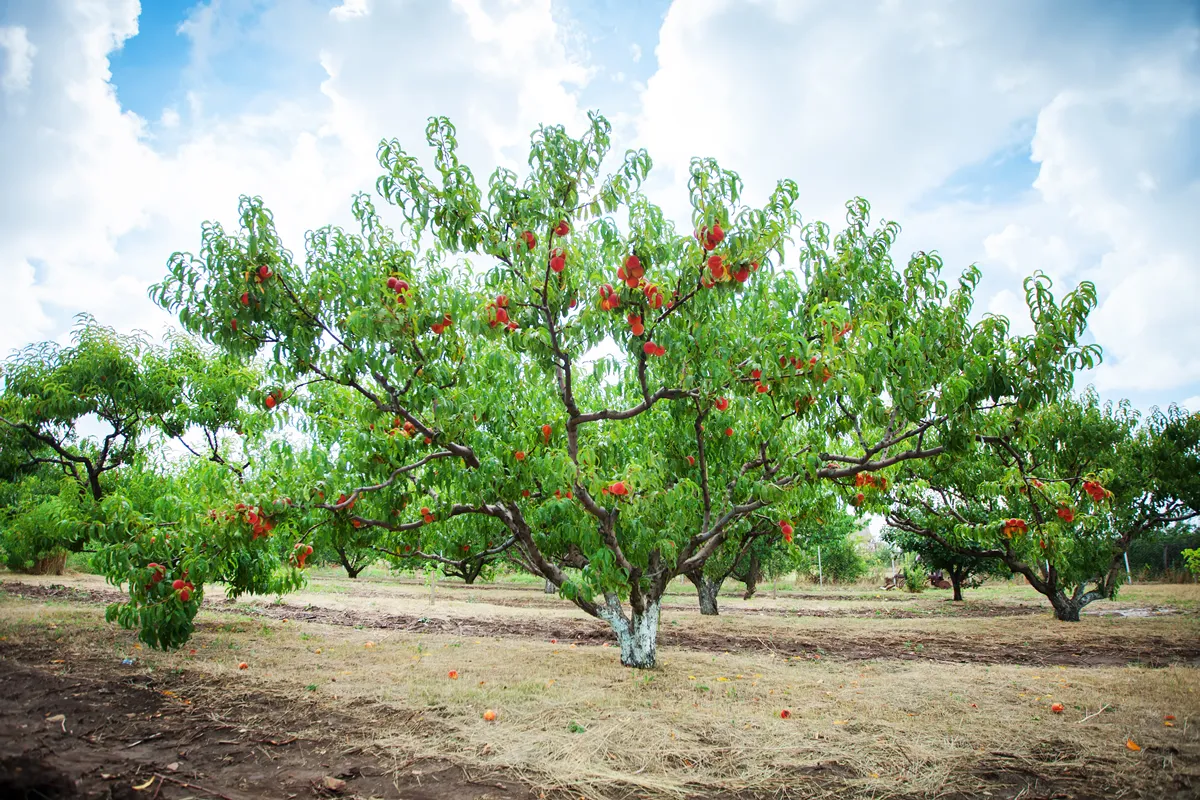 Peach tree with fruits growing in the garden. Peach orchard.
Peach tree with fruits growing in the garden. Peach orchard.
Deciding where to plant your peach tree is the first step towards a bountiful harvest. Before making any hasty decisions, take some time to consider the factors that can influence the growth and yield of your tree. Factors such as climate, soil type, and available sunlight are all important to ensuring your peach tree flourishes. While some peach tree varieties thrive in humid climates, others prefer the drier temperatures of arid regions. Paying attention to these details can make a huge difference in your peach tree's success and ultimately, your enjoyment of its juicy, delicious fruit.
The best time to plant a peach tree is in late winter or early spring. This timing allows the tree to establish its roots in the soil before the growing season begins. It's important to ensure that the risk of frost has passed as new growth can be damaged by freezing temperatures. If you're planting a bare root tree, it should be planted while it's still dormant, which is typically during the late winter or early spring. If the tree you're planting has been grown in a pot, it can technically be planted at any time of the year, but it will still appreciate being planted in early spring when it can focus on root development. Remember, always check the specific recommendations for your climate zone and the variety of peach tree you have chosen.
The best place to plant a peach tree is in a location that receives full sunlight for at least six hours each day, preferably in the morning when the sun is less intense. Peach trees thrive under full exposure to sunlight as it helps them produce the best quality fruit.
The planting site should also have good air circulation to help prevent diseases such as leaf curl and fungal infections. If possible, choose a slightly elevated site because cold air will sink into lower areas and potentially damage the tree during frosty conditions.
As for the soil, peach trees prefer well-drained, fertile soil with a pH between 6.0 and 7.0. The soil should be deep enough to accommodate the tree's roots, which can extend 2 feet or more into the ground. Sandy loam or loamy sand is often ideal because it drains well while retaining enough moisture and nutrients for the tree's needs.
Avoid planting peach trees in low spots where water tends to pool, as standing water can lead to Root Rot and other problems. Also, keep in mind that peach trees need plenty of space to grow, so they should be planted at least 15 to 20 feet away from buildings, other trees, or large structures.
Lastly, if you live in a colder climate, consider planting the tree on the south or west side of your property. These locations tend to be warmer and can help protect the tree from cold winter winds.
Understanding Soil Requirements and Planting Depth
If you're eager to become a successful gardener, understanding soil requirements and planting depth is essential. Proper soil preparation and planting technique can make a significant difference in the growth and health of your plants. By knowing the soil requirements of your plants, you can adjust the pH level, improve drainage, and provide the necessary nutrients they need for optimal growth and development.
Additionally, planting depth plays a crucial role in providing the right environment for the plant's roots to grow and thrive. Researching and understanding the specific plants you want to grow can save you time and money in the long run, as you'll maximize your harvest while minimizing plant loss. In short, taking the time to understand soil requirements and planting depth is essential to achieve a bountiful and successful garden.
A Step-by-Step Guide to Planting a Peach Tree
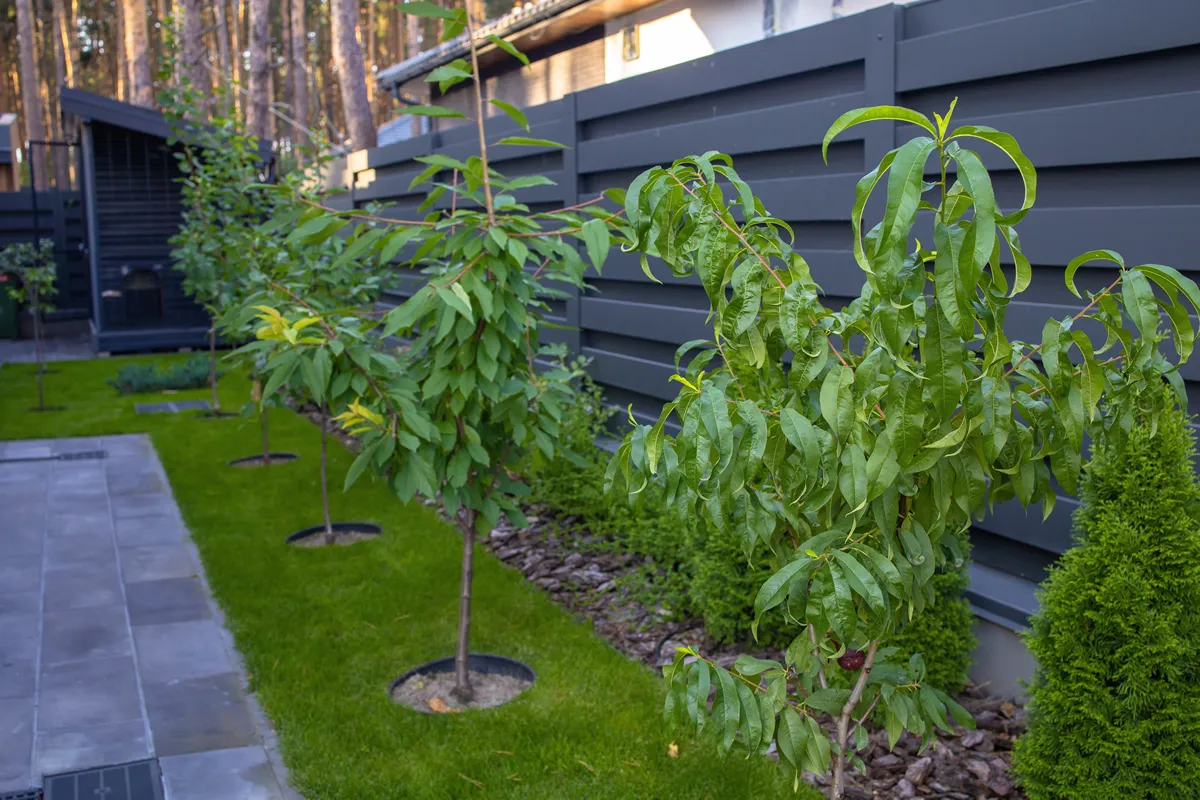 young peach trees at their summer cottage
young peach trees at their summer cottage
Planting a peach tree is a rewarding task that requires careful preparation and attention. Here's a step-by-step guide on how to do it:
Materials Needed:- A young peach tree
- Shovel or trowel
- Compost or well-rotted manure
- Mulch
- Watering can or hose
- Stake and ties (if necessary)
- Choose the Right Time: The best time to plant a peach tree is in late winter or early spring when the tree is still dormant but the ground is workable.
- Select the Site: Choose a location that gets at least six hours of direct sunlight each day. The site should have well-draining soil and enough space for the tree to grow, at least 15-20 feet away from buildings or other trees.
- Prepare the Hole: Dig a hole twice as wide and just as deep as the root ball of your tree. This gives the roots plenty of room to spread out.
- Enrich the Soil: Mix some compost or well-rotted manure into the soil you've removed from the hole. This will provide nutrients to the tree as it establishes itself.
- Plant the Tree: Place the tree in the center of the hole. The top of the root ball should be level with or slightly above the surrounding soil to allow for settling. Backfill the hole with the enriched soil, firming it gently around the base of the tree.
- Water Thoroughly: After planting, water the tree generously to settle the soil and eliminate any air pockets.
- Mulch the Base: Apply a layer of mulch around the base of the tree (but not touching the trunk) to help retain moisture and suppress weeds.
- Stake if Necessary: If your tree is tall or the location is windy, you might need to stake the tree for the first year to provide support. Attach the tree to the stake using ties, making sure not to damage the trunk.
- Ongoing Care: Water the tree regularly, especially during dry periods. Monitor the tree for signs of pests or disease.
Remember, a newly planted peach tree may take a few years to produce fruit, but with proper care, it can provide a bountiful harvest for many years to come. Happy planting!
Preparing the Soil for Planting and How to Plant a Peach Tree
Preparing the soil before planting is crucial for a successful harvest. When it comes to planting peach trees, the soil should be well-drained and fertile. Start by removing any weeds or grass in the area where the tree will be planted. Turn the soil and add organic matter, like compost or aged manure, to achieve the right texture and nutrient balance. Make sure the hole for the tree is twice as wide as the root ball and at the same depth. Plant the tree in the hole, ensuring that the graft union is 2 inches above the soil level. Gently pack the soil around the root ball, water thoroughly, and add a layer of mulch to protect the soil and maintain moisture levels. With proper care and attention, a healthy peach tree will soon provide delicious fruit for years to come.
Preparing the soil properly before planting a peach tree is crucial to its growth and fruit production. Here's how you can prepare the soil for a peach tree in the UK:
Materials Needed:- Garden fork or tiller
- Compost or well-rotted manure
- Balanced fertilizer (optional)
- Soil pH testing kit
- Select the Right Spot: Peach trees need a location with full sun (at least six hours of direct sunlight per day) and good air circulation. The soil should be well-draining as peach trees don't do well in waterlogged conditions.
- Check the Soil pH: Peach trees prefer slightly acidic to neutral soil, with a pH between 6.0 and 7.0. You can test your soil pH with a kit from a garden center. If your soil is too acidic, you can add garden lime to raise the pH. If it's too alkaline, incorporate sulfur or peat moss to lower the pH.
- Prepare the Ground: Use a garden fork or tiller to break up the soil in an area about 3-4 feet in diameter where you plan to plant the tree. This will make it easier for the roots to establish themselves.
- Enrich the Soil: Mix in a generous amount of compost or well-rotted manure to boost the nutrient content of the soil.
- Add Fertilizer: While not always necessary, especially if you've added compost or manure, you could also mix in a balanced fertilizer to provide additional nutrients. Follow the package instructions for proper application rates.
- Let the Soil Settle: If possible, allow the soil to settle for a week or two before planting your peach tree. This gives the amendments time to start working their way into the soil.
Remember, ongoing soil care is just as important as initial preparation. Mulching around the base of the tree (without touching the trunk) can help retain moisture, suppress weeds, and gradually add nutrients back into the soil as it decomposes. Regularly check the soil condition and add more compost or fertilizer as necessary.
Caring for Young Trees During the First Year
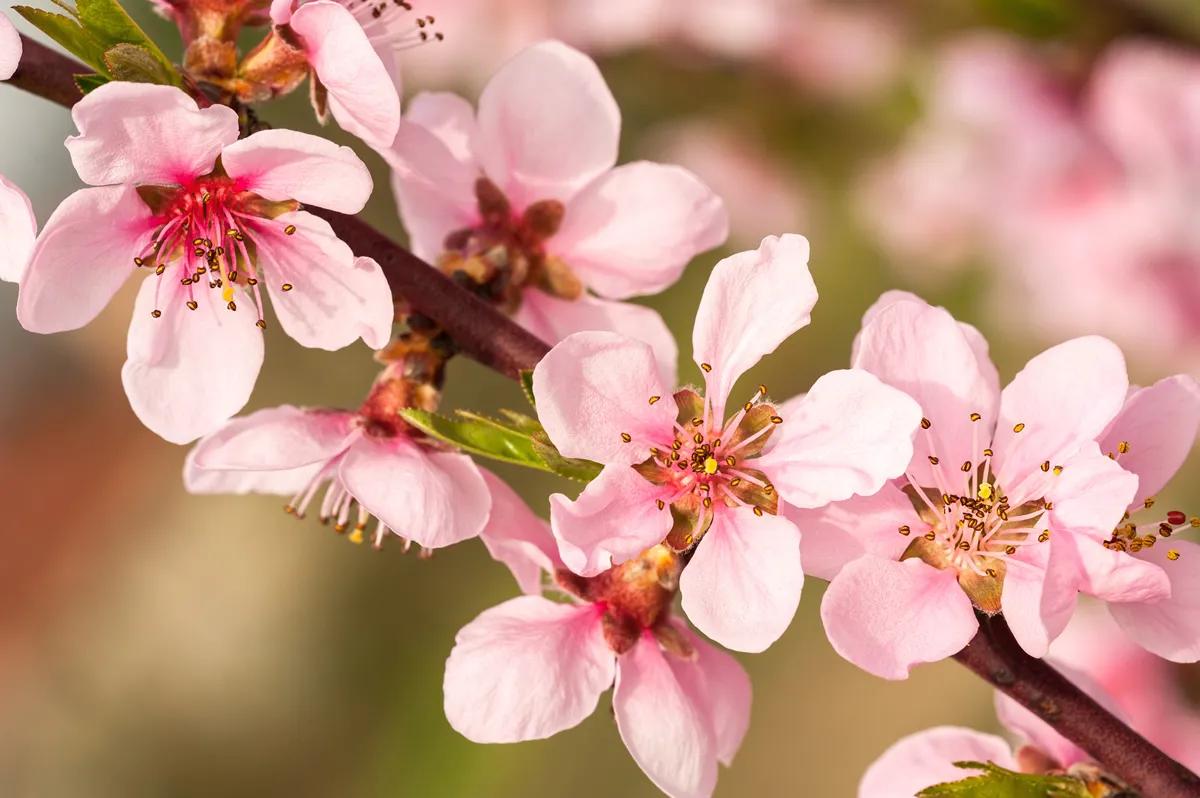 Peach tree flowers
Peach tree flowers
When it comes to young trees, the first year is crucial for their growth and survival. It's important to closely monitor their progress and provide them with the care they need to flourish in their new environment. This includes regular watering, especially during hot and dry weather conditions, as well as adding a layer of mulch to help retain moisture and regulate soil temperature. Proper pruning and training can also help young trees develop a strong framework for future growth. By investing time and effort into caring for young trees during their first year, you can help ensure they establish strong roots and thrive for years to come.
Caring for young peach trees during their first year is crucial to their growth and future fruit production. Here's a guide on how to do it:
- Watering: Young peach trees need consistent watering to establish their root system. Water deeply once a week, but adjust based on weather conditions. If it's particularly hot or dry, you may need to water more often.
- Fertilizing: About six weeks after planting, apply a balanced 10-10-10 fertilizer around your peach tree. Start with one pound for each new tree. This will provide the necessary nutrients for the tree to grow strong and healthy.
- Pruning: Prune newly planted peach trees to about 24 to 30 inches tall to encourage a strong, open center shape that allows sunlight to reach the leaves, thus enhancing fruit production. Remove any side shoots during the first summer.
- Mulching: Apply a layer of mulch around the base of the tree to help retain moisture, control weeds, and regulate soil temperature. Be sure not to mound mulch against the trunk of the tree as it can promote rot and disease.
- Pest and Disease Control: Monitor the tree regularly for signs of pests or disease. Common issues include Peach Leaf Curl, Aphids, and peach tree borers. Consult with a local extension service or nursery for advice on treatment if you notice anything unusual.
- Protecting from Weather: If frost is forecasted in late spring when your tree has blossomed, try to protect the blossoms by covering the tree with a frost blanket at night.
Remember, patience is key. It may take a few years before your tree produces fruit, but with proper care, you'll have a healthy peach tree ready to provide a bountiful harvest.
A peach tree typically starts to bear fruit 2 to 4 years after planting. If you're growing a peach tree from seed, it may take between 3 to 4 years before they start bearing fruit. However, if you plant a young peach tree, it may start producing fruit slightly earlier, usually between two to four years after planting. Dwarf varieties can sometimes bear fruit a year sooner, around 1 to 3 years after planting. Please note that these are general estimates and the exact timing can vary depending on the specific variety of the peach tree, the growing conditions, and how well the tree is cared for.
Establishing an Effective Watering Schedule
Establishing an effective watering schedule is crucial for maintaining a healthy and vibrant garden. While many gardeners assume that watering plants daily is the way to go, this can actually do more harm than good.
Overwatering can lead to Root Rot and other issues that can stunt plant growth or kill off your precious flowers and vegetables altogether.
On the other hand, depriving plants of water for too long can lead to wilting and drying out. The key to an effective watering schedule is finding the right balance based on your specific plants and their individual needs. Consider factors such as soil type, sun exposure, and weather conditions when determining how often and how much to water. With a little bit of research and trial and error, you can establish a watering routine that will keep your garden thriving throughout the growing season.
Provide proper watering and nutrients for a healthy Peach Tree
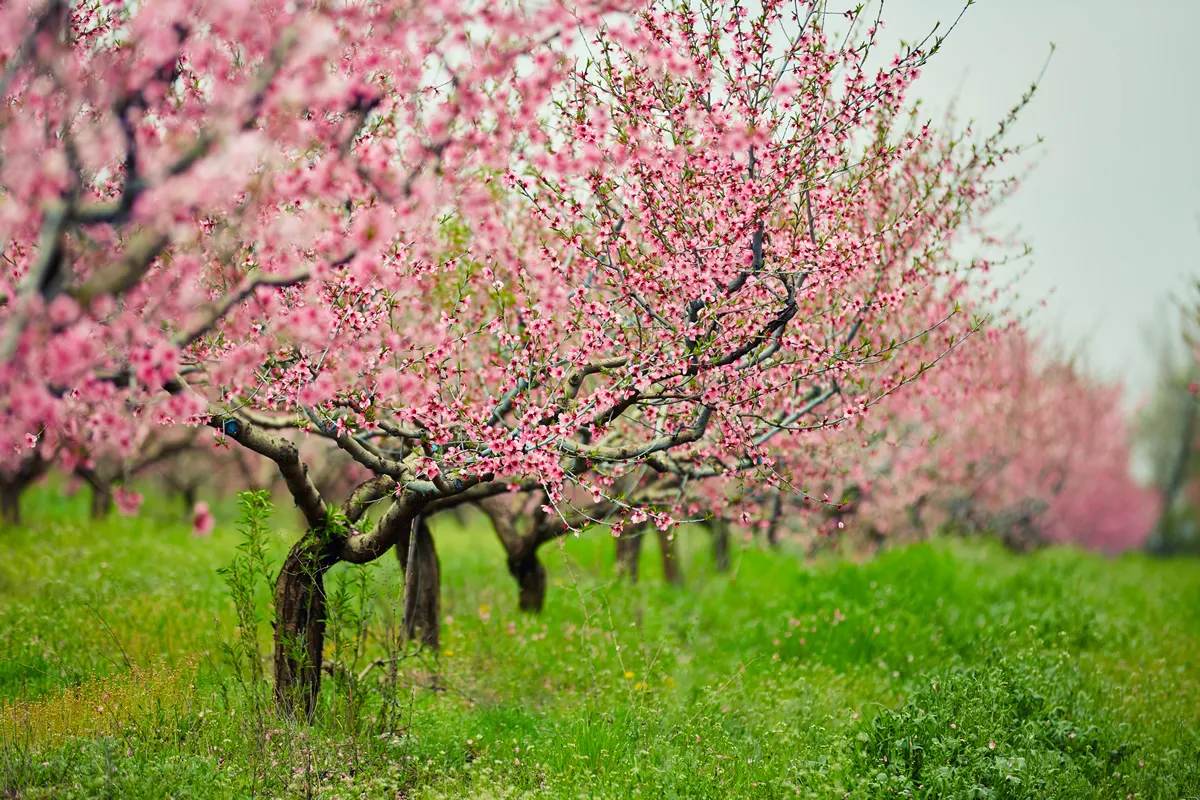 peach trees with flowers
peach trees with flowers
A healthy peach tree is a wonder to see and its bountiful harvest can bring joy to anyone's taste buds. To achieve such a wonder, it is crucial to provide proper watering and nutrients to the tree. Regularly watering the tree is essential, especially during hot and dry weather conditions. The soil should be moist but not waterlogged to avoid Root Rot.
Nutrient-rich soil is another key factor to consider when caring for a peach tree. Fertilizing the tree periodically with organic fertilizers is recommended to keep the tree healthy and maximise fruit production. Paying attention to these vital aspects will ensure your peach tree thrives and rewards you with a delicious bounty!
The Best Nutrients for Peach Trees and When to Apply ThemPeach trees, like all plants, require specific nutrients to thrive. The primary nutrients needed by peach trees are nitrogen (N), phosphorus (P), and potassium (K), known as the N-P-K ratio on fertilizer bags. Here's an overview of these nutrients and when to apply them:
- Nitrogen (N): This nutrient promotes healthy leaf and shoot growth. It's especially important in the early life of the tree and during periods of rapid growth.
- Phosphorus (P): Phosphorus helps with energy transfer and storage, which is vital for root development and fruiting.
- Potassium (K): Potassium supports overall plant health. It aids in water regulation within the plant and contributes to disease resistance.
In addition to these primary nutrients, peach trees also benefit from secondary nutrients like calcium, magnesium, and sulfur, as well as trace minerals such as iron, zinc, copper, molybdenum, and boron.
When and How to Apply Fertilizer:- First Year: Six weeks after planting your peach tree, apply a balanced 10-10-10 fertilizer, or one specifically formulated for fruit trees. Start with one pound of fertilizer spread evenly around the base of the tree, avoiding contact with the trunk.
- Second Year and Beyond: In subsequent years, apply fertilizer in early spring before new growth starts. Increase the amount of fertilizer by one pound per year until you're applying a maximum of three pounds for mature trees.
- Heavy Clay Soils: If your soil is heavy clay, consider applying half the recommended amount of fertilizer twice a year: once in early spring and again in early summer.
- Soil Testing: For the most accurate fertilization plan, consider having your soil tested. This will provide information about what nutrients your soil is lacking and allow you to choose a fertilizer that best meets your tree's needs.
Remember, over-fertilizing can be just as harmful as under-fertilizing. Too much nitrogen, for example, can lead to lush foliage but poor fruit production. Always follow package instructions when applying fertilizer.
The Common Pests and Diseases which effect the Peach Tree in the UK
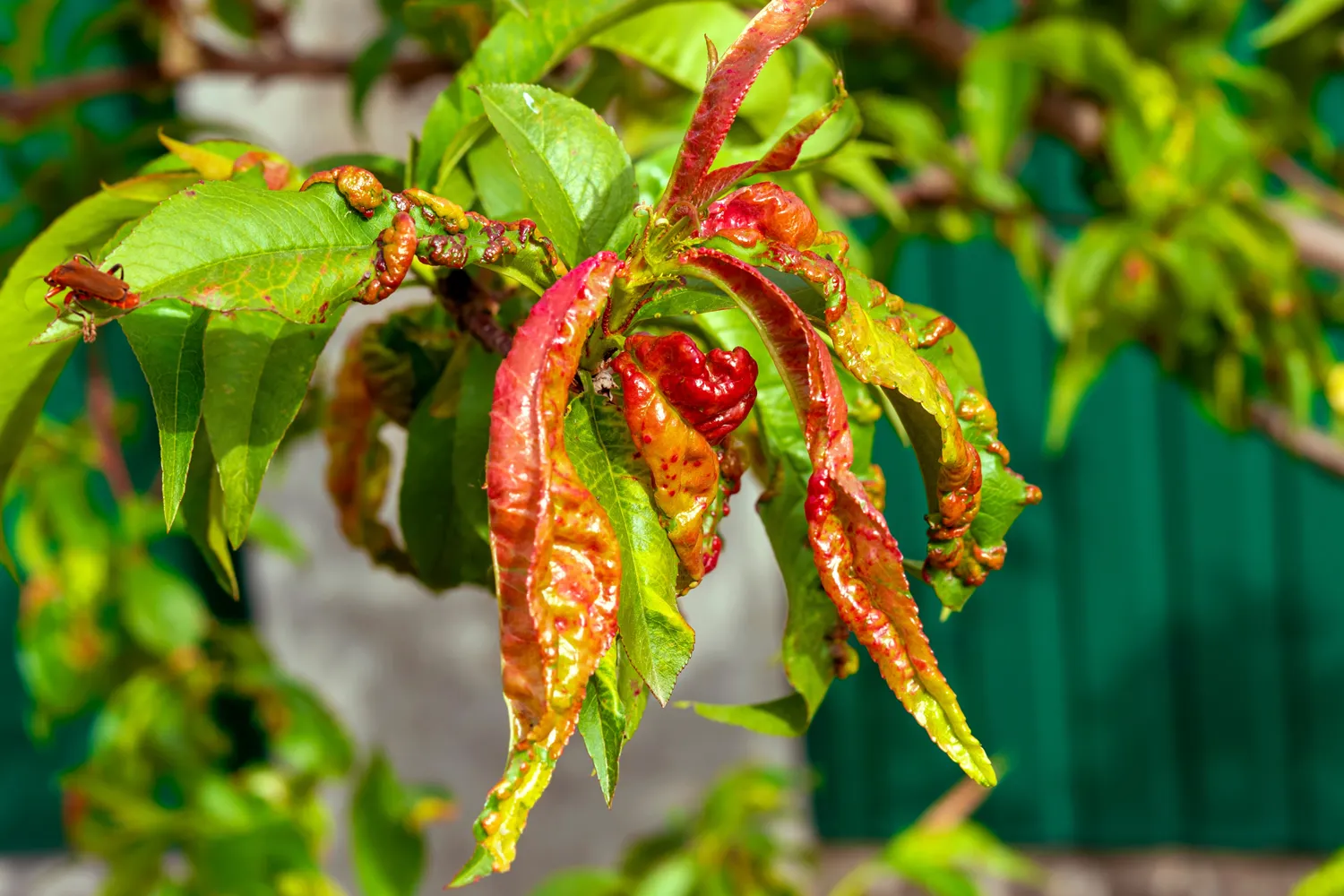 Peach leaf curl. Fungal disease of peaches tree. Taphrina deformans. Peach tree fungus disease.
Peach leaf curl. Fungal disease of peaches tree. Taphrina deformans. Peach tree fungus disease.
Peach trees are a beautiful addition to any garden, but they are unfortunately vulnerable to a variety of pests and diseases in the UK. One common pest that afflicts these trees is the peach potato aphid, which feeds on the sap of the tree and can cause the leaves to curl up and turn yellow. Peach trees are also susceptible to bacterial canker, a disease that causes dark patches on the bark and can eventually kill the tree. Another disease to watch out for is Peach Leaf Curl, which causes the leaves to become distorted and discoloured. While these problems can be discouraging for gardeners, with proper care and attention, it is possible to keep peach trees healthy and productive.
The peach potato aphid
, scientifically known as Myzus persicae, is a small aphid species that is also commonly referred to as the green peach aphid or greenfly. This pest is globally distributed and has a host range of over 400 species, which includes many economically important crops.Adults are usually 1-2mm long and can be varying shades, from green to pale yellow and even pink. They are oval in shape and can be found in colonies on the undersides of leaves or on stems.
Peach potato Aphids are known for their ability to transmit viruses between plants, making them a significant threat to agriculture. They are particularly problematic for sweet pepper, tomato, cucumber, and many other greenhouse crops.
Controlling these pests typically involves integrated pest management strategies, which may include biological controls, such as introducing natural predators like ladybugs and Lacewings. Chemical controls may also be used, but this aphid has shown a capacity for developing resistance to many insecticides, making it a challenging pest to manage.
Comprehensive List of Pests and Diseases Affecting Peach Trees
Pests
-
Peach Tree Borer:
Symptoms: Wilting, yellowing leaves, gumming and sawdust-like frass at the base of the tree.
Causes: Larvae of a type of moth that burrows into the trunk.
Remedies: Use of pheromone traps to catch adult moths, application of insecticides, and pruning of infested branches.
The peach tree borer (Synanthedon exitiosa) is a significant pest of stone fruit trees, including peaches, plums, cherries, and nectarines. Despite its name, the peach tree borer doesn't just affect peach trees.
Appearance: Adult peach tree borers resemble wasps. Females are larger and have a dark blue-black body with yellow-orange bands. Males are smaller and clear-winged. The larvae, which cause the damage, are white or cream-coloured caterpillars with a brown head.
Symptoms: Damage by peach tree borers includes wilting, yellowing leaves, and reduced vigor of the tree. One of the most distinctive signs is a gummy, sawdust-like substance (known as frass) around the base of the tree where the larvae have burrowed into the trunk.
Life Cycle: The adult peach tree borer lays eggs on the tree bark in late summer. These hatch into larvae that bore into the tree to feed, usually at or below ground level. They overwinter inside the tree, resume feeding in spring, and then pupate to emerge as adults in summer.
Management: Control measures for peach tree borers include monitoring for signs of infestation, use of pheromone traps to catch adult moths, application of insecticides timed to kill newly hatched larvae before they enter the tree, and physical removal of larvae where possible. It's also helpful to maintain overall tree health, as stressed trees are more susceptible to borer attack.
-
Aphids:
Symptoms: Curled, yellow leaves and a sticky substance on leaves or under the tree.
Causes: Small bugs that suck sap from the tree.
Remedies: Application of insecticidal soaps or oils, introducing natural predators like ladybugs.
Aphids are small, soft-bodied insects that can be problematic on peach trees, as well as a variety of other plants. They are often found in clusters and come in various colours, including green, black, and pink.
Symptoms: Aphids feed by sucking sap from the plant, which can cause leaves to curl, yellow, or distort. They also excrete a sticky substance known as honeydew, which can lead to the growth of sooty mold fungus on the leaves and fruit.
Life Cycle: Aphids have a complex life cycle with both sexual and asexual reproduction, and they can quickly reproduce in large numbers when conditions are favorable.
Management: Several strategies can be used to manage Aphids on peach trees. Beneficial insects, such as ladybugs, Lacewings, and certain types of wasps, are natural predators of Aphids. Encouraging these beneficial insects can help keep aphid populations in check.
Insecticidal soaps or oils can also be effective against Aphids. These are typically sprayed onto the tree, making sure to reach the undersides of leaves where Aphids often reside.
For severe infestations, stronger insecticides may be necessary. However, these should be used sparingly, as they can also kill beneficial insects and lead to an increase in aphid populations over time.
It's also worth noting that maintaining overall tree health can help it withstand aphid damage. This includes proper watering, fertilizing, and pruning practices.
-
Oriental Fruit Moth:
Symptoms: Wilting terminal shoots, holes in fruits filled with frass.
Causes: Larvae of a moth species that burrows into shoots and fruits.
Remedies: Use of pheromone traps, application of appropriate insecticides.
The Oriental fruit moth (Grapholita molesta) is a significant pest of stone fruits, particularly peaches and nectarines, but it can also affect other fruits like quince, apricot, apple, plum, cherry, and pear.
Appearance: Adult oriental fruit moths are small, grayish moths about 0.4 inch long. The larvae, which cause the damage, are small caterpillars that vary in colour from cream to pink.
Symptoms: The main damage caused by the Oriental fruit moth comes from the larvae, which bore into the shoots and fruit of the host trees. In peach trees, a newly hatched larva enters the tender, growing twig at its tip near the base of a leaf or fruit. This causes the shoot tips to wilt, a symptom often referred to as "flagging". Larvae can also tunnel into the fruit, causing direct damage and making the fruit susceptible to secondary infections.
Life Cycle: The Oriental fruit moth has multiple generations per year. Adults emerge in spring and lay their eggs on the leaves and fruit of host plants. The larvae hatch and begin feeding, then pupate and emerge as adults to start the cycle again.
Management: Monitoring with pheromone traps can help determine when the moths are active and guide the timing of control measures. Insecticide applications may be necessary, particularly for commercial growers. Home gardeners might consider less toxic options like Bacillus thuringiensis (Bt), a naturally occurring bacteria that kills the larvae. Maintaining good sanitation practices, such as removing and destroying infested fruit and pruning flagged shoots, can also help reduce populations.
Diseases
-
Peach Leaf Curl:
Symptoms: Reddish, curled leaves in spring.
Causes: Fungus Taphrina deformans, particularly in wet, cool spring weather.
Remedies: Application of a fungicide in late winter or early spring before buds break.
Peach Leaf Curl is a common fungal disease that affects peach trees, as well as nectarines and some other stone fruit. The fungus responsible for this disease is Taphrina deformans. The symptoms of Peach Leaf Curl are quite distinctive and usually appear in spring as the leaves begin to grow. Infected leaves become distorted and curl up, often changing colour to red or purple before eventually turning gray or white as the fungus produces spores. In addition to affecting leaves, Peach Leaf Curl can also cause deformities in blossoms and fruit. Severe infections can lead to leaf drop and reduced fruit yield.
Preventive measures are the most effective way to manage Peach Leaf Curl. This typically involves applying a fungicide spray in late winter or early spring before the buds break.
Once symptoms have appeared, it's generally too late to treat the infection for that year. However, maintaining tree vigor with proper watering and fertilizing can help it withstand the disease.
-
Brown Rot:
Symptoms: Brown, rotting fruit often covered with tan spore masses.
Causes: Fungus Monilinia fructicola, especially in warm, wet weather.
Remedies: Regular pruning for air circulation, removal of infected fruits, application of fungicides.
Brown Rot is a common and destructive fungal disease that affects peach trees and other stone fruits. The fungus responsible for Brown Rot is Monilinia fructicola.
Symptoms: The first sign of Brown Rot is often small, circular brown spots on the fruit. These spots rapidly enlarge and cause the fruit to rot. The affected area becomes covered with tan, spore-producing structures, giving it a fuzzy appearance. In severe cases, the entire fruit may become mummified and remain attached to the tree. The fungus can also infect blossoms and twigs, causing blossom blight and cankers.
Causes: The Brown Rot fungus overwinters in mummified fruit and infected twigs. During periods of wet, warm weather in spring, the fungus produces spores that are spread by rain or insects. The spores can infect blossoms or young fruit, especially if they're injured.
Remedies: Management of Brown Rot involves several strategies. First, sanitation is crucial - remove and dispose of any mummified fruit or infected plant material to reduce sources of infection. Prune trees to improve air circulation and allow sunlight to penetrate, which helps the tree dry out faster after rain.
Fungicides can be effective, but timing is important. They should be applied at bloom time to protect flowers and again as the fruit begins to colour. Always follow the manufacturer's instructions when applying fungicides.
Finally, avoid injuring the fruit, as wounds provide an entry point for the fungus. Be careful when pruning or picking fruit, and control insect pests that can cause damage.
-
Peach Scab:
Symptoms: Small, velvety spots on fruit.
Causes: Fungus Cladosporium carpophilum, particularly in warm, wet conditions.
Remedies: Regular application of fungicides during periods of new growth. Peach Scab, caused by the fungus Cladosporium carpophilum, is a common disease affecting peach trees and other stone fruits.
Symptoms: The main symptom of Peach Scab is the presence of small, velvety spots on the fruit. These spots are usually dark and raised, often described as "freckles". Over time, they may coalesce to form larger patches. While the disease mainly affects the fruit's skin, it can also cause lesions on leaves and twigs.
Causes: The Peach Scab fungus overwinters in twig lesions and begins producing spores in spring. These spores are spread by rain or wind to infect new growth. Warm, wet conditions favor the development of the disease.
Remedies: To manage Peach Scab, start with preventative measures. Prune the tree to improve air circulation and sunlight penetration, which can help reduce the humidity that the fungus thrives in. Sanitation is also important - remove and dispose of any fallen leaves or fruit that could harbor the fungus.
Fungicides are typically used to control Peach Scab. They should be applied regularly during periods of new growth, from petal fall until about four weeks before harvest. The exact timing and frequency of applications can depend on local weather conditions and disease pressure.
Remember, while Peach Scab affects the appearance of the fruit, it usually doesn't affect the fruit's edibility. If you can tolerate some spots on your peaches, you might opt for a less rigorous control strategy.
-
Bacterial Canker:
Symptoms: Gumming, cankers on tree trunk, dieback of branches.
Causes: Bacteria Pseudomonas syringae, especially in wet, cool weather.
Remedies: Pruning of infected branches, application of copper-based sprays in autumn or early spring.
Bacterial canker is a serious disease that can affect peach trees, caused by the bacteria Pseudomonas syringae.
Symptoms: Symptoms of bacterial canker include gumming (a sticky, amber-coloured substance oozing from the tree), cankers (sunken, dead areas) on the tree trunk or branches, and dieback of branches. Leaves may wilt and turn yellow or brown. In severe cases, the disease can cause tree death.
Causes: The bacteria enters trees through injured bark or existing wounds, such as those caused by pruning or frost injury. Wet, cool weather conditions favor the development and spread of the disease.
Remedies: Management of bacterial canker starts with prevention. Avoid injuring the tree, as wounds provide entry points for the bacteria. Prune only in dry weather, and sterilize pruning tools between cuts.
If the disease is already present, prune out infected branches, cutting well below the canker into healthy wood. Dispose of infected material away from healthy trees to prevent the spread of the bacteria.
Copper-based sprays can be used to help control bacterial canker. They are typically applied in autumn after leaf fall or in early spring before bud break to kill bacteria on the tree surface.
In addition to these measures, maintaining overall tree health can help it resist and recover from bacterial canker. This includes proper watering, fertilizing, and other good cultural practices.
Remember, prevention is easier than cure. Regular monitoring, proper watering, fertilizing, and pruning practices can help keep your peach tree healthy and more resistant to pests and diseases.
When to Harvest a Peach Tree
Peach trees are a delicious addition to any backyard garden. Knowing when to harvest them for maximum flavour is key to enjoying your crop to its full potential. Generally, peaches are ready to be picked from mid to late summer, depending on the variety. You can tell if a peach is ready by looking at its colour – when it turns from green to a golden-yellow hue, it’s a sure sign it’s time to harvest.
Another way to test if a peach is ripe is to gently squeeze it – if it yields to pressure, it’s ready to be picked. However, it’s important not to wait too long to harvest your peaches, as they can quickly become overripe and develop a mealy texture. With a little bit of patience and practice, you’ll be able to enjoy perfectly ripe, juicy peaches all summer long.
Growing a Peach Tree in Pots and Containers
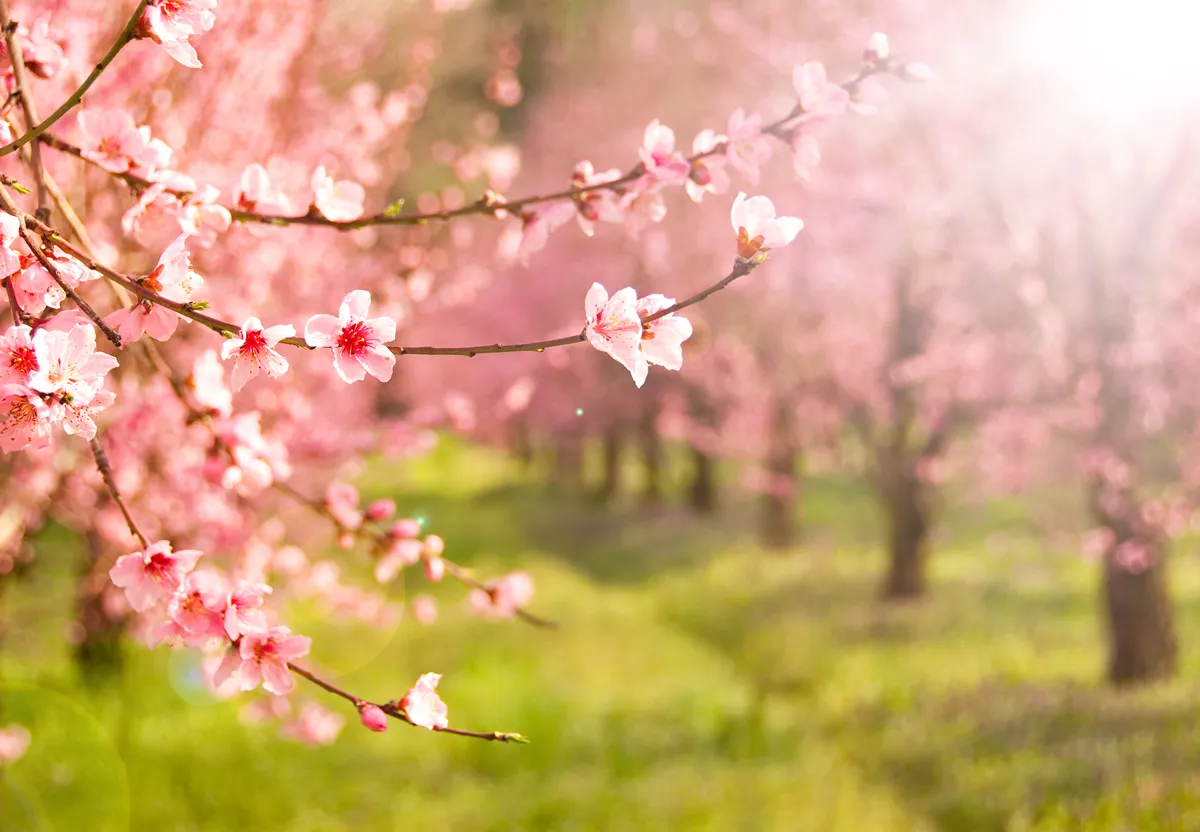 Branches of cherry tree in blossom
Branches of cherry tree in blossom
Growing a peach tree in pots and containers is not only a practical solution for those with small gardens, but it also adds beauty and freshness to any outdoor space. Container gardening is a great way to take control of the growing environment and create the perfect conditions for your tree to flourish. With a few simple steps and some basic knowledge, you can enjoy the beauty and delicious taste of fresh peaches right from your patio or balcony. Imagine the sweet fragrance of ripening fruits wafting through the air and the satisfaction of growing your own produce. Whether you're a seasoned gardener or just starting, growing a peach tree in a container is a fun and rewarding experience.
Planting a peach tree in a pot or container allows you to grow your own fresh fruit even if you have limited space. Here's a step-by-step guide on how to do it:
- 1. Choose the Right Tree: Select a dwarf variety of peach tree, as these are more suited to container growing. Look for healthy, disease-free trees from a reputable nursery.
- 2. Choose the Right Container: The pot should be large enough to accommodate the tree's root system with room to grow. A container with a diameter of about 24 inches is a good starting point. Make sure the pot has adequate drainage holes to prevent waterlogging.
- 3. Prepare the Pot: Cover the bottom of the pot with a layer of gravel or small stones to improve drainage. Then, fill the pot about one-third full with a well-draining potting mix.
- 4. Plant the Tree: Remove the tree from its nursery pot and gently loosen the roots. Place the tree in the center of the pot and add more potting mix until the root ball is covered and the soil level is just below the top of the pot. The graft union (if visible) should be above the soil level.
- 5. Water and Fertilize: After planting, give the tree a good watering until the water runs out the bottom of the pot. Apply a slow-release fertilizer according to the package instructions.
- 6. Position the Pot: Place the pot in a sunny location where the tree will get at least six hours of direct sunlight each day.
- 7. Ongoing Care: Regularly check the soil moisture and water when the top inch feels dry. Prune the tree in late winter to maintain a manageable size and shape, and to encourage fruit production. Watch for pests and diseases, and treat as necessary.
Remember, peach trees grown in pots will need to be repotted every few years as they outgrow their containers. This also gives you a chance to refresh the potting mix and inspect the roots. With the right care, your peach tree should provide you with a delicious crop of fresh fruit for many years to come. Enjoy!
Once your tree has been planted in its pot, it's important to remember that regular maintenance is essential for keeping it healthy and producing the best possible harvest. Pruning is key - remove any dead or damaged branches and thin the canopy to keep air circulating around the tree. This will help to prevent fungal diseases such as Peach Leaf Curl from affecting your crop. Similarly, keeping weeds away and applying a mulch around the base of the tree can help to retain moisture in the soil and protect against pests.
Finally, it's essential to fertilize your tree regularly with a balanced fertilizer to ensure it receives all the nutrients it needs. You can either use a slow-release fertilizer or apply liquid feed weekly during the growing season. With this simple maintenance plan, you'll soon be enjoying delicious home-grown peaches!
With such an abundance of ripe fruit, it's easy to be tempted to pick your peaches before they're ready
There are several dwarf peach tree varieties available in the UK that are well-suited to pot or container gardening. These include:
- Garden Lady: A slow-growing dwarf variety, self-fertile and produces golden coloured fruit.
- Terrace Amber: Part of the Dwarf Fruit Range, this variety is known for its naturally occurring dwarfism.
- Avalon Pride: This variety has pretty pink flowers and bears large, juicy fruits. It's adapted to grow in different container sizes and is self-fertile.
- Bonanza: A popular mini peach tree variety that produces good-sized, yellow-fleshed fruits.
- Honey Babe: This is a very compact, dwarf peach tree that yields full-sized, sweet peaches.
- Pix Zee: Another compact variety that produces large, delicious peaches.
Remember, availability can vary, so check with local nurseries or online suppliers to see what's currently in stock.
Top 10 Tips to Growing Healthy Peach Trees in the UK
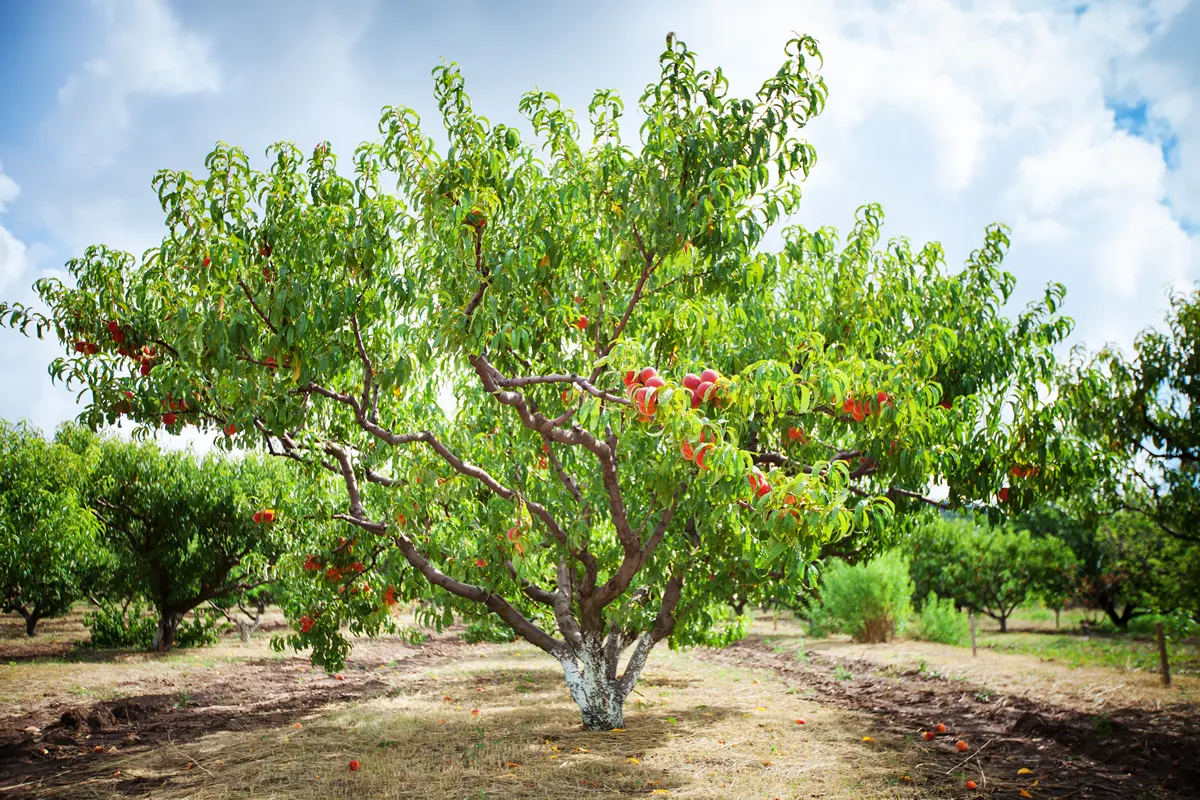 Peach tree with fruits growing in the garden. Peach orchard.
Peach tree with fruits growing in the garden. Peach orchard.
Peach trees are a beautiful addition to any garden in the UK, but they require specific care to ensure they remain healthy and bear fruit. Here are 10 top tips to help you grow healthy peach trees:
Firstly, ensure the soil is well-draining and has a pH level between 6.0 and 6.5.
Secondly, prune the tree during the dormant season to encourage new growth.
Thirdly, thin the fruit to prevent overcrowding and avoid the tree's branches breaking under the weight of too much fruit.
Fourthly, water regularly but do not overwater, as this can cause Root Rot.
Fifthly, fertilize the tree twice a year using a balanced fertilizer.
Sixthly, protect the tree from frost during the winter by wrapping the trunk with insulation.
Seventhly, mulch around the tree's base to suppress weeds and retain moisture.
Eighthly, watch out for pests and diseases such as Peach Leaf Curl.
Ninthly, consider planting a second peach tree to aid cross-pollination.
And lastly, harvest the fruit when it's fully ripe and store it in a cool location. With these tips, you'll be on track to growing healthy and fruitful peach trees in the UK.
Frequently Asked Questions on Peach Trees
- How do I plant a peach tree?
- When is the best time to plant a peach tree?
- How often should I water my peach tree?
- What kind of soil does a peach tree need?
- When and how should I prune my peach tree?
- How long does it take for a peach tree to bear fruit?
- What are common pests and diseases of peach trees?
- How can I protect my peach tree from pests and diseases?
- Why are the leaves on my peach tree curling or turning yellow?
- How do I know when my peaches are ripe and ready to pick?
A Complete Guide to Pruning a Peach Tree in the UK
If you’re a UK gardener with peach trees, then you know how important it is to prune them in order to ensure healthy growth and a good harvest. With proper pruning techniques, peach trees can flourish and produce beautiful blossoms for years to come. To help give your tree the best chance of success, this guide explains every step involved in pruning peach trees correctly – from identifying the structure and timing the cuts right through to disposing of debris after completion. Read on for all you need to know about expertly caring for your peach trees!
Prepare the peach tree for pruning by removing dead and diseased branches
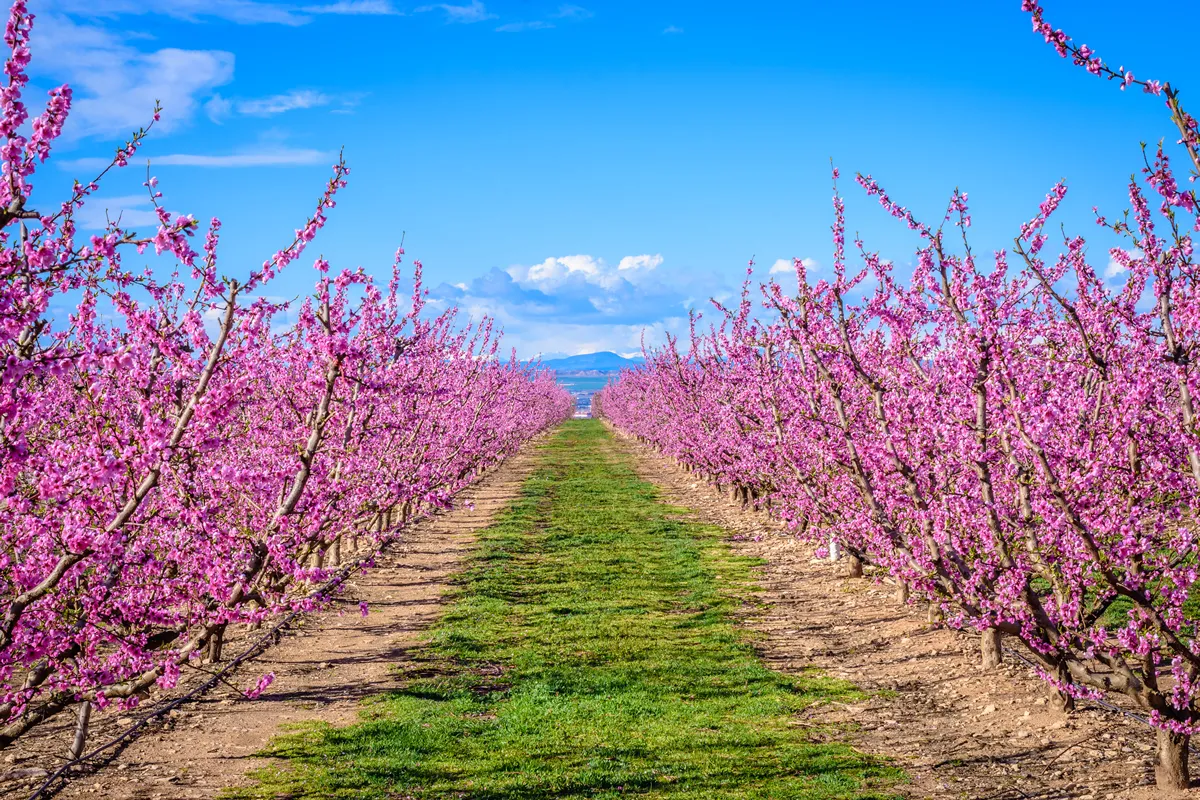 Peach trees blooming in the spring (Aitona, Lerida, Catalonia, Spain)
Peach trees blooming in the spring (Aitona, Lerida, Catalonia, Spain)
The peach tree is an important fruit-bearing tree that requires special care to thrive. In order to keep your peach tree healthy and producing a bountiful harvest, it's essential to stay on top of pruning. Before you start, it's important to ensure that you're equipped with the right tools, including sharp pruning shears and loppers. Once you're prepared, you can commence the pruning process by removing any dead or diseased branches. This not only helps to keep your tree healthy, but it also ensures that it produces the highest quality fruit possible. So, roll up your sleeves and get to work - your peach tree will thank you for it!
Pruning a peach tree helps to improve air circulation, sunlight exposure, and overall fruit production. Here's a step-by-step guide on how to prune a peach tree:
- 1. Choose the Right Time: The best time to prune a peach tree is in early spring before the buds break, but after the risk of severe cold has passed.
- 2. Gather Your Tools: You will need a pair of sharp pruning shears for smaller branches, loppers for larger ones, and possibly a pruning saw for very large branches. Make sure your tools are clean and sharp to make clean cuts and reduce the risk of disease.
- 3. Inspect the Tree: Before you start pruning, take a good look at your tree. Identify any branches that are dead, diseased, or damaged - these will be your first targets. Also note any branches that cross each other or grow inward toward the center of the tree.
- 4. Remove Dead, Diseased, or Damaged Branches: Start your pruning by removing these branches. Make your cut close to the branch collar (the slightly swollen area where the branch connects to the trunk or another branch) without cutting into it.
- 5. Thin Out the Canopy: Remove branches that cross each other or grow inward. The goal is to open up the center of the tree to allow more light and air penetration.
- 6. Shorten Long Branches: Cut back overly long branches to help maintain the tree's shape and balance. A typical peach tree should have a somewhat vase or bowl shape, with the center open.
- 7. Remove Suckers and Water Sprouts: These are vigorous shoots that grow from the base of the tree or straight up from the branches, respectively. They don't produce fruit and take energy away from the rest of the tree.
- 8. Clean Up: Once you've finished pruning, clean up the cut branches and dispose of them properly. Don't leave them near your tree, as they could harbor pests or diseases.
- 9. Monitor the Tree: After pruning, keep an eye on your tree. It should start to produce new growth as the weather warms. If you notice any signs of disease or pest activity, take appropriate action.
Remember, pruning can be stressful for a tree, so it's important not to remove more than 25-30% of the canopy in a single year. If your tree needs extensive pruning, it may be better to spread it out over two or three years.
Learn how to identify the different types of fruiting wood on a peach tree
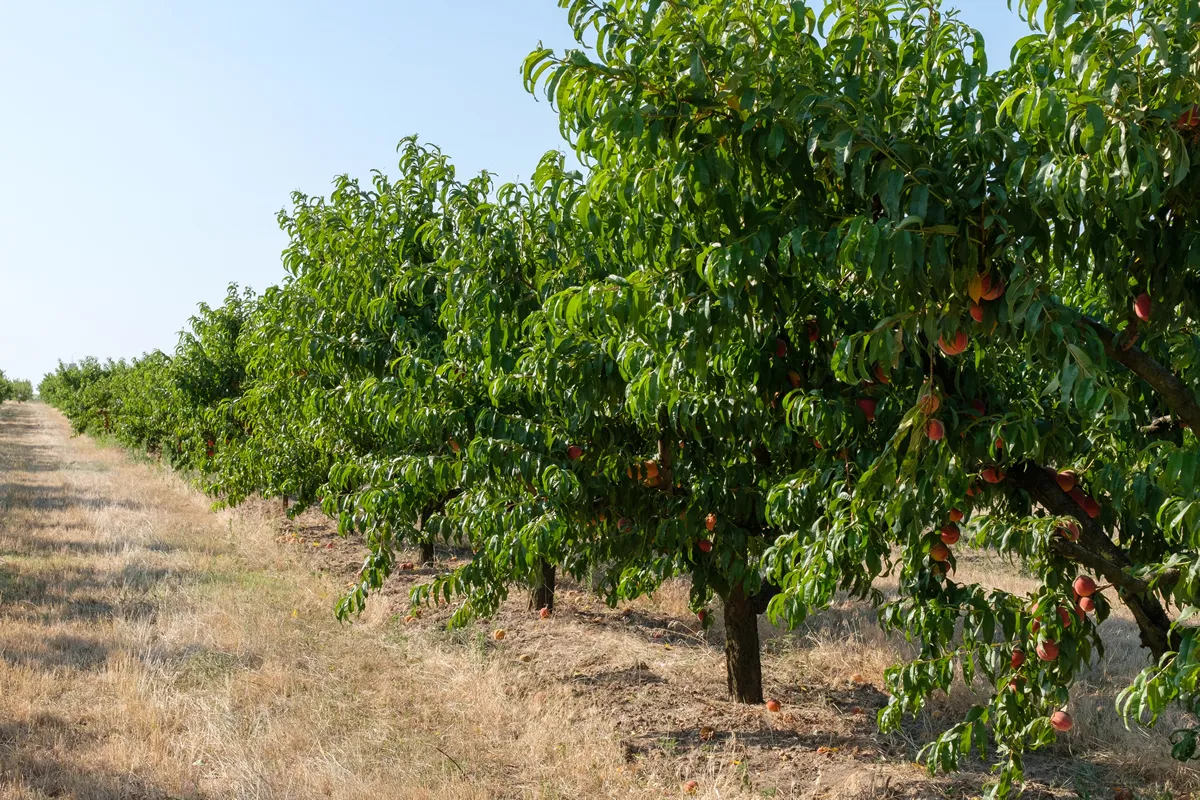 Close up shots of peaches an peach trees in bright sunshine
Close up shots of peaches an peach trees in bright sunshine
A Peach tree can be a beautiful addition to any garden, but to make sure you get the most out of your tree, it's important to learn how to identify its fruiting wood. Fruiting wood refers to the branches on the tree that produce fruit. By understanding the different types of fruiting wood on your Peach tree, you’ll be able to manage it effectively and encourage the most bountiful harvest possible.
It's essential to identify the difference between old and new wood and to know which one is likely to produce fruit. With the right knowledge, you'll be able to prune your Peach tree, ensuring that it produces the best fruit year after year.
Select healthy shoots to keep and determine which need to be removed
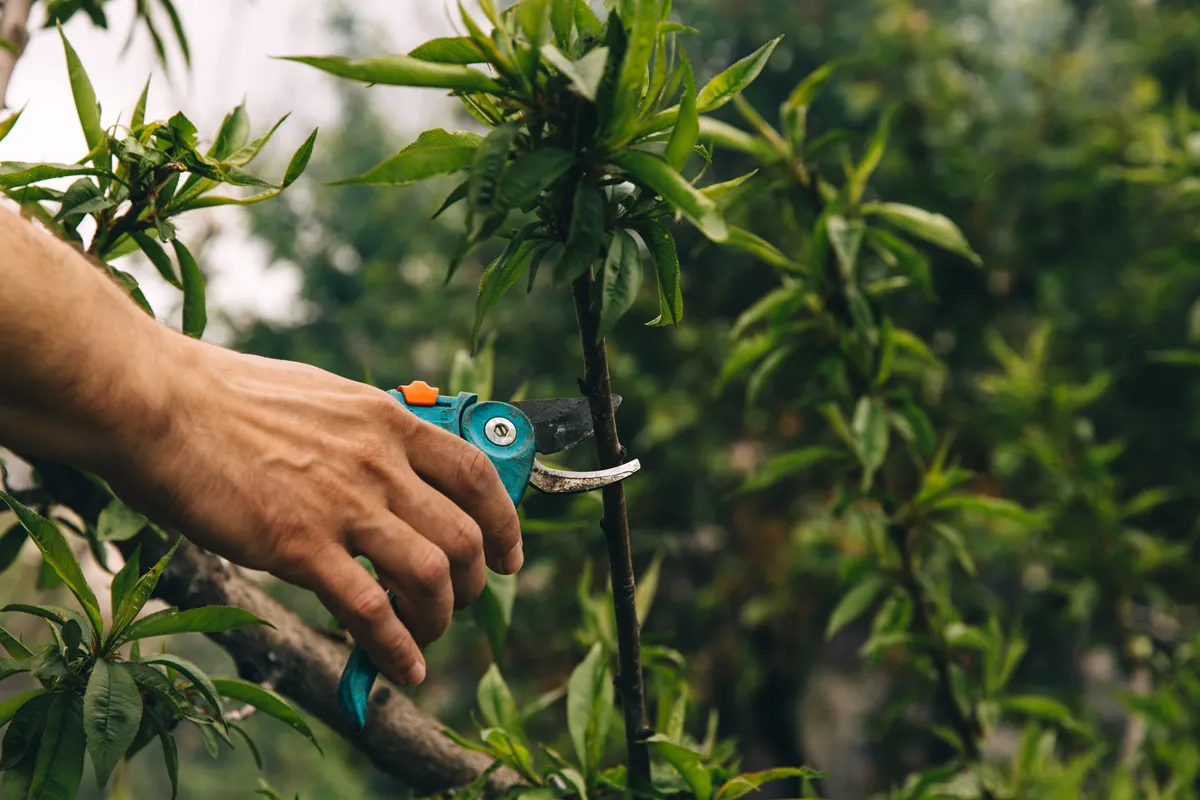 Pruning of peach tree. Pruning branches to form a crown. Blooming garden, care, fertilizer. Removing branches with a short-handled pruner. Horticulture, agriculture, growing vegetables and fruits.
Pruning of peach tree. Pruning branches to form a crown. Blooming garden, care, fertilizer. Removing branches with a short-handled pruner. Horticulture, agriculture, growing vegetables and fruits.
Caring for plants can be a tricky process, especially when it comes to selecting which shoots to keep and which ones to remove. A healthy plant requires careful attention to detail, and choosing the right branches can make all the difference. It's important to observe how the plant is growing and identify where new growth is coming from. Healthy shoots that are thriving should be kept and encouraged to grow, while those that are weak or dying should be removed. By taking the time to properly assess the plant's growth, you can ensure that it remains vigorous and flourishing.
Prune away new growth from the previous season for better fruit production
 Peach and cherry trees bloom in Niagara on the Lake, Ontario, Canada.
Peach and cherry trees bloom in Niagara on the Lake, Ontario, Canada.
To ensure the best possible fruit production, it's important to prune away any new growth from the previous season. While it may seem counterintuitive to cut away healthy-looking branches, doing so allows the plant to focus its energy on producing quality fruit rather than wasting it on unnecessary growth.
In addition, it can help prevent diseases and pests from taking hold and reduce the risk of branches breaking under the weight of heavy fruit. With a bit of careful pruning, you can set your fruit trees up for success and enjoy a bountiful harvest come harvest season.
Use thinning cuts carefully to open up the canopy of the tree and allow more light in
 Ripe peach close-up with peach orchard in the background.
Ripe peach close-up with peach orchard in the background.
When it comes to caring for trees, it's important to strike a balance between promoting healthy growth and preserving a tree's natural shape. Thinning cuts can be a useful tool in achieving this balance, but they should be used carefully to avoid damaging the tree. Thinning cuts involve selectively removing branches to open up the canopy and allow more light to penetrate the tree. This can help improve the overall health of the tree and promote new growth in areas that were previously shaded.
However, it's important to avoid overdoing it with thinning cuts, as too many cuts can weaken the tree and make it more vulnerable to disease and pests. Properly pruning a tree takes skill and knowledge, so if you're unsure about how to use thinning cuts on your trees, it's best to consult with a professional arborist.
Cut off old, non-productive wood, as well as any crossing or rubbing branches
 Fresh and delicious peaches in the orchard.
Fresh and delicious peaches in the orchard.
As spring approaches, it's time to give your trees some TLC. One important step in tree care is to cut off old, non-productive wood, as well as any crossing or rubbing branches. Not only does this promote the growth of new, healthy branches, but it also helps prevent potential hazards that can occur when branches rub together or cross each other. By taking a proactive approach to pruning, you'll be able to enjoy a beautiful, healthy, and safe tree for years to come. So, grab your pruners and get ready to give your trees the love they deserve!
After pruning your peach tree, there are several steps you can take to ensure it stays healthy and recovers well:
- 1. Watering: After pruning, your peach tree may require additional watering to help it recover, especially if weather conditions are dry. However, be careful not to overwater as this can lead to Root Rot.
- 2. Mulching: Mulching around the base of the tree can help retain soil moisture and suppress weeds that could compete with the tree for nutrients.
- 3. Fertilizing: Pruning stimulates new growth, so providing the right nutrients can support this process. Use a balanced fertilizer suitable for fruit trees and follow the package instructions for application rates and timings.
- 4. Monitor for Pests and Disease: Pruning wounds can sometimes attract pests or create an entry point for diseases. Keep an eye on your tree for any signs of trouble, such as discoloured leaves, oozing sap, or unusual insects.
- 5. Protect Pruning Wounds: In general, pruning cuts should heal naturally without the need for wound dressings. However, in some cases (such as when pruning during periods of wet weather or when dealing with a disease-prone tree), using a tree wound dressing might be beneficial.
- 6. Follow-up Pruning: As the tree recovers, there may be a burst of new growth around the pruning sites. Some of this may need to be pruned back to maintain the tree's form and ensure energy is directed towards fruit production.
Remember, caring for a peach tree after pruning involves ongoing observation and care. By regularly checking on the tree's health and addressing any issues promptly, you can help ensure a good recovery and abundant fruit production.
How to Prune Climbing Vines
List by Variety
- How to Prune Actinidia
- How to Prune Akebia
- How to Prune Bougainvillea
- How to Prune Campsis
- How to Prune Celastrus
- How to Prune Chilean Glory Vine
- How to Prune Clematis Armandii
- How to Prune Clematis Montana
- How to Prune Climbing Rose
- How to Prune Hedera GoldHeart
- How to Prune Honeysuckle
- How to Prune Hydrangea Petiolaris
- How to Prune Ivy
- How to Prune Japanese Wisteria
- How to Prune Morning Glory
- How to Prune Parthenocissus
- How to Prune Persian Ivy Hedera Colchica
- How to Prune Schisandra
- How to Prune Star Jasmine
- How to Prune Sweet Peas
- How to Prune True Jasmine
- How to Prune Virginia Creeper
- How to Prune Wisteria
How to Prune Hedges
List by Variety
- How to Prune an Arborvitae Hedge
- How to Prune a Barberry Hedge
- How to Prune a Beech Hedge
- How to Prune a Boxwood Hedge
- How to Prune a Butterfly Bush Hedge
- How to Prune a Cotoneaster Hedge
- How to Prune an English Lavender Hedge
- How to Prune an Escallonia Hedge
- How to Prune an Euonymus-Hedge
- How to Prune a Firethorn Hedge
- How to Prune a Forsythia Hedge
- How to Prune a Griselinia Hedge
- How to Prune a Hawthorn Hedge
- How to Prune a Holly Hedge
- How to Prune a Hornbeam Hedge
- How to Prune a Laurel Hedge
- How to Prune a Leylandii Hedge
- How to Prune a Lilac Hedge
- How to Prune a Maple Leaf Viburnum Hedge
- How to Prune a Photinia Hedge
- How to Prune a Pink Ramanus Rose Hedge
- How to Prune a Privet Hedge
- How to Prune a Pyracantha Hedge
- How to Prune a Spirea Hedge
- How to Prune a Thuja Hedge
- How to Prune a Viburnum Hedge
- How to Prune a Western Red Cedar Hedge
- How to Prune a Yew Hedge
How to Prune Shrubs
List by Variety
- How to Prune an Abelia Shrub
- How to Prune an Abutilon
- How to Prune an Acer / Japanese-Maple
- How to Prune an Amelanchiers
- How to Prune an Apple-Tree
- How to Prune an Arbovitae Shrub
- How to Prune an Arbutus
- How to Prune an Aucuba
- How to Prune a Azalea Mollis
- How to Prune Azaleas
- How to Prune a Bay Tree Shrub
- How to Prune a Berberis Darwinii
- How to Prune Berberis Deciduous Types
- How to Prune a Boxwood Shrubs
- How to Prune a Brachyglottis Senecio
- How to Prune a Buddleia Alternifolia
- How to Prune Buddleias Butterfly Bushes
- How to Prune a Buddleja Globosa
- How to Prune a Callicarpa
- How to Prune a Camellia
- How to Prune a Caryopteris
- How to Prune a Catalpa Bignonioides Aurea
- How to Prune Ceanothus Deciduous Types
- How to Prune Ceanothus Evergreen Types
- How to Prune a Ceratostigma
- How to Prune a Chaenomeles
- How to Prune a Choisya
- How to Prune a Cistus
- How to Prune a Clematis
- How to Prune a Cornus
- How to Prune a Cotinus Royal Purple
- How to Prune a Cytisus Scoparius
- How to Prune a Exochorda x Macrantha
- How to Prune a Forsythia
- How to Prune a Hebe
- How to Prune a Hydrangeas
- How to Prune Juniper Shrubs
- How to Prune a Lavatera
- How to Prune Lilac Bushes
- How to Prune a Mugo Pine
- How to Prune Rose Bushes
- How to Prune Spirea Shrubs
- How to Prune Viburnum Shrubs
- How to Prune a Weigela
- How to Prune a Yew
How to Prune Trees
List by Variety
- How to Prune a Apple Tree
- How to Prune a Apricot Tree
- How to Prune a Ash Tree
- How to Prune a Birch Tree
- How to Prune a Cherry Tree
- How to Prune a Elm Tree
- How to Prune a Fig Tree
- How to Prune a Grape Tree
- How to Prune a Hickory Tree
- How to Prune a Maple Tree
- How to Prune a Oak Tree
- How to Prune an Olive Tree
- How to Prune a Peach Tree
- How to Prune a Pear Tree
- How to Prune a Plum Tree
- How to Prune a Poplar Tree
- How to Prune a Walnut Tree
Pests and Diseases
- How to Protect from Anthracnose
- How to Protect from Athids
- How to Protect from Apple Scab
- How to Protect from Armillaria Root Rot
- How to Protect from Bagworms
- How to Protect from Black Knot
- How to Protect from Black Rot
- How to Protect from Black Spot
- How to Protect from Botryosphaeria Dieback
- How to Protect from Botrytis Blight
- How to Protect from Brown Rot
- How to Protect from Canker Diseases
- How to Protect from Caterpillars
- How to Protect from Cedar Apple Rust
- How to Protect from Clematis Wilt
- How to Protect from Codling Moths
- How to Protect from Crown Gall
- How to Protect from Crown Rot
- How to Protect from Downy Mildew
- How to Protect from Dutch Elm Disease
- How to Protect from Elm Bark Beetle
- How to Protect from Elm Leaf Beetle
- How to Protect from Fire Blight
- How to Protect from the Gypsy Moth Caterpillars
- How to Protect from Honey Fungus
- How to Protect from Japanese Beetles
- How to Protect from Juniper Scale
- How to Protect from Lace Bugs
- How to Protect from Lacewings
- How to Protect from Leaf Miners
- How to Protect from Leaf Spot Diseases
- How to Protect from Mealybugs
- How to Protect from Needle Blight
- How to Protect from Oak Borers
- How to Protect from Oak Wilt
- How to Protect from Olive Knot Disease
- How to Protect from Peach Leaf Curl
- How to Protect from Peach Scab
- How to Protect from Pear Psylla
- How to Protect from Pear Rust
- How to Protect from Pear Scab
- How to Protect from Perennial Canker
- How to Protect from Pine Sawflies
- How to Protect from Pine Shoot Beetle
- How to Protect from Plum Fruit Moth
- How to Protect from Plum Pox Virus
- How to Protect from Poplar Borer
- How to Protect from Powdery Mildew
- How to Protect from Root Rot
- How to Protect from Rose Rosette Disease
- How to Protect from Rust Fungi
- How to Protect from Scale Insects
- How to Protect from Silver Leaf Disease
- How to Protect from Slugs
- How to Protect from Spider Mites
- How to Protect from Twig Blight
- How to Protect from Verticillium Wilt
- How to Protect from Viburnum Beetle
- How to Protect from Vine Weevil
- How to Protect from Walnut Blight
- How to Protect from Walnut Husk Fly
- How to Protect from Walnut Scale
- How to Protect from Western Flower Thrips
- How to Protect from Whiteflies
Popular Pruning Sections

General Pruning
General Information on How to Prune your Garden
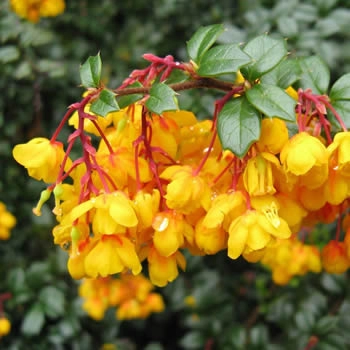
Pruning Shrubs
The Most Read Shrubs to Prune
- How to Prune Hydrangeas
- How to Prune a Rose Bush
- How to Prune Azaleas
- How to Prune a Lilac Bush
- How to Prune Buddleias - Butterfly Bushes
- How to Prune Forsythia
- How to Prune Weigela
- How to Prune Hebe
- How to Prune Camellia

Pruning Trees and Climbers
The Most Read Trees to Prune
- How to Prune Apple Trees
- Pruning Plum Trees
- Pruning Cherry Trees
- Pruning Olive Trees
- How to Prune a Grape Vine
- Acer Pruning | Pruning Japanese Maple
- How to Prune a Fig Tree
- Pruning Peach Trees
- Pruning Pear Trees
- How to Prune a Plum Tree

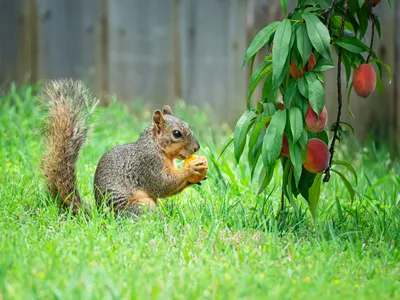 Hungry Squirrel (Sciurus niger) eating peach fruit
Hungry Squirrel (Sciurus niger) eating peach fruit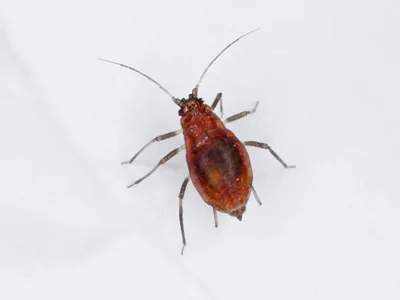 Myzus persicae, known as the green peach aphid or the peach-potato aphid
Myzus persicae, known as the green peach aphid or the peach-potato aphid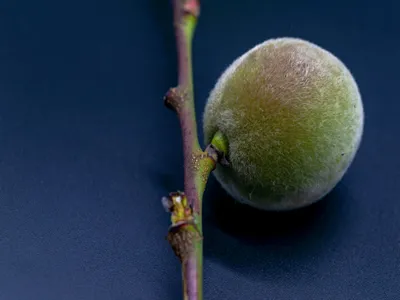 Powdery mildew of peach is a disease of fruits.
Powdery mildew of peach is a disease of fruits.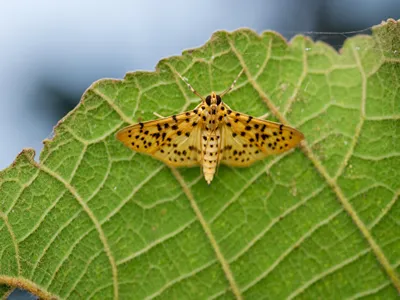 Yellow Peach Moth resting under the leaf
Yellow Peach Moth resting under the leaf Myzus persicae, known as the green peach aphid or the peach-potato aphid
Myzus persicae, known as the green peach aphid or the peach-potato aphid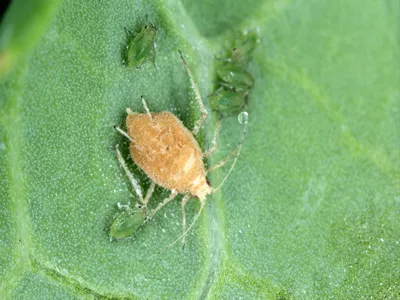 Myzus persicae, known as the green peach aphid or the peach-potato aphid
Myzus persicae, known as the green peach aphid or the peach-potato aphid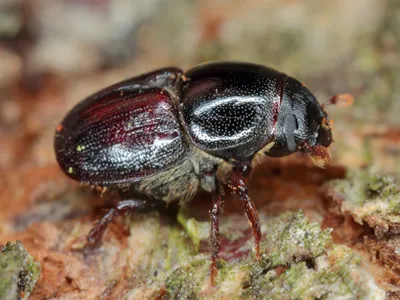 Scolytus mali - larger shothole borer
Scolytus mali - larger shothole borer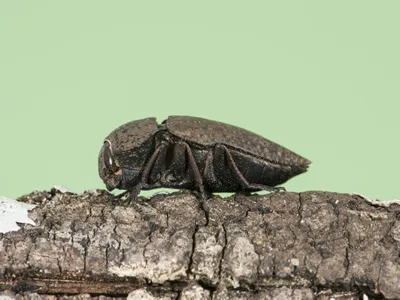 Capnodis tenebricosa headed worm, of the peach tree
Capnodis tenebricosa headed worm, of the peach tree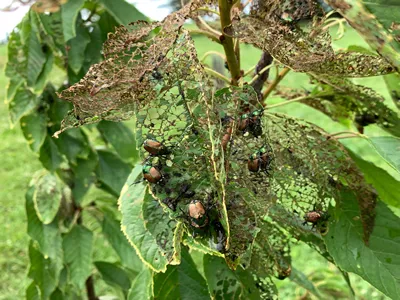 Invasive Japanese beetles eat the foliage off a peach tree
Invasive Japanese beetles eat the foliage off a peach tree